American Indian Pottery
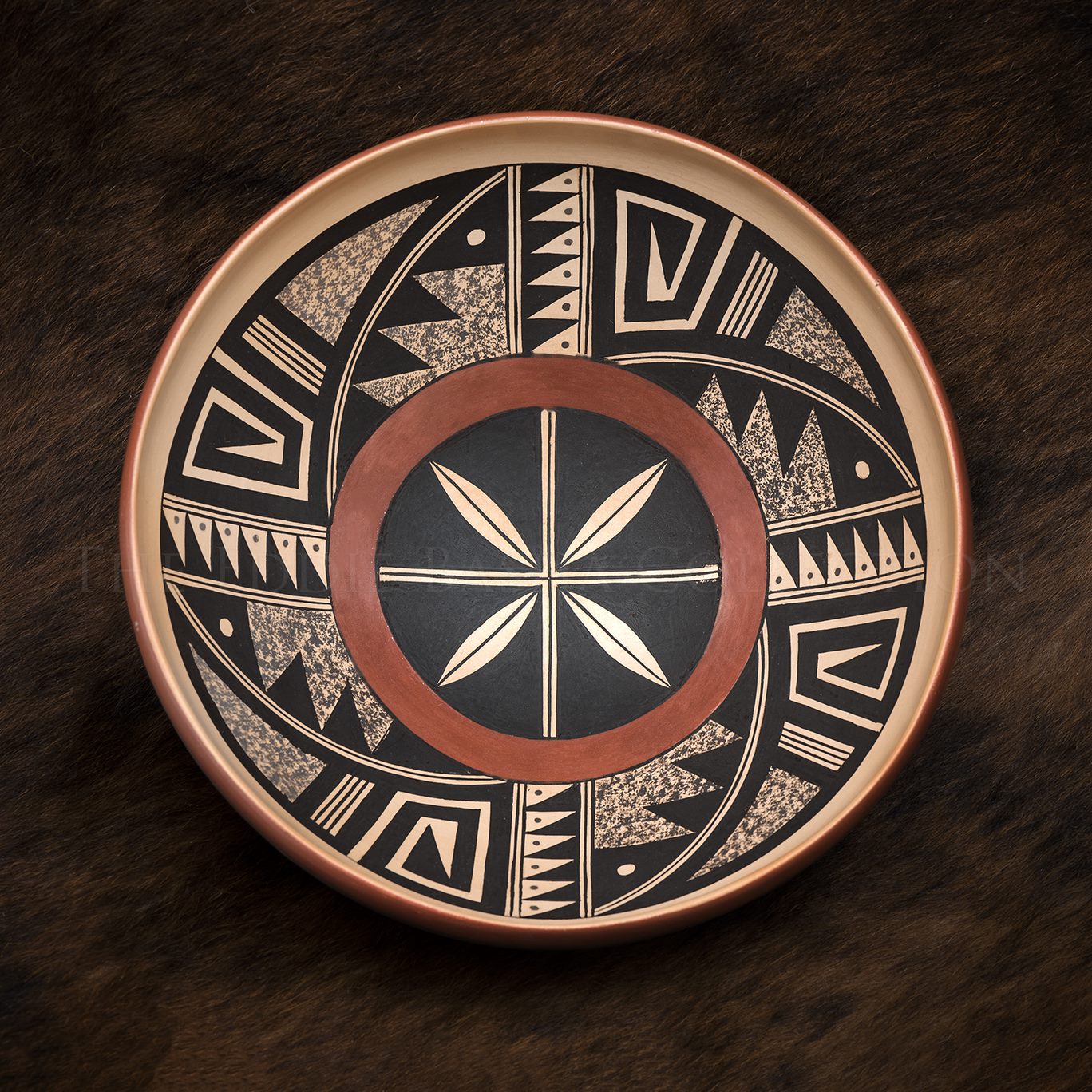
Four Feathers Bowl | Steve Lucas (b.1955)
Artist: American Indian Potter
Description: Polychrome Sikyatki Style Pottery | Dimensions: 4”h x 7”diameterpottery
Steve Lucas’ pottery practice is centered
upon his respect and admiration for traditional Hopi pottery-making processes but with reinterpreted, contemporary design elements based upon the ancient sikyátki style. This bowl features repeated geometric shapes repeated in each quarter.
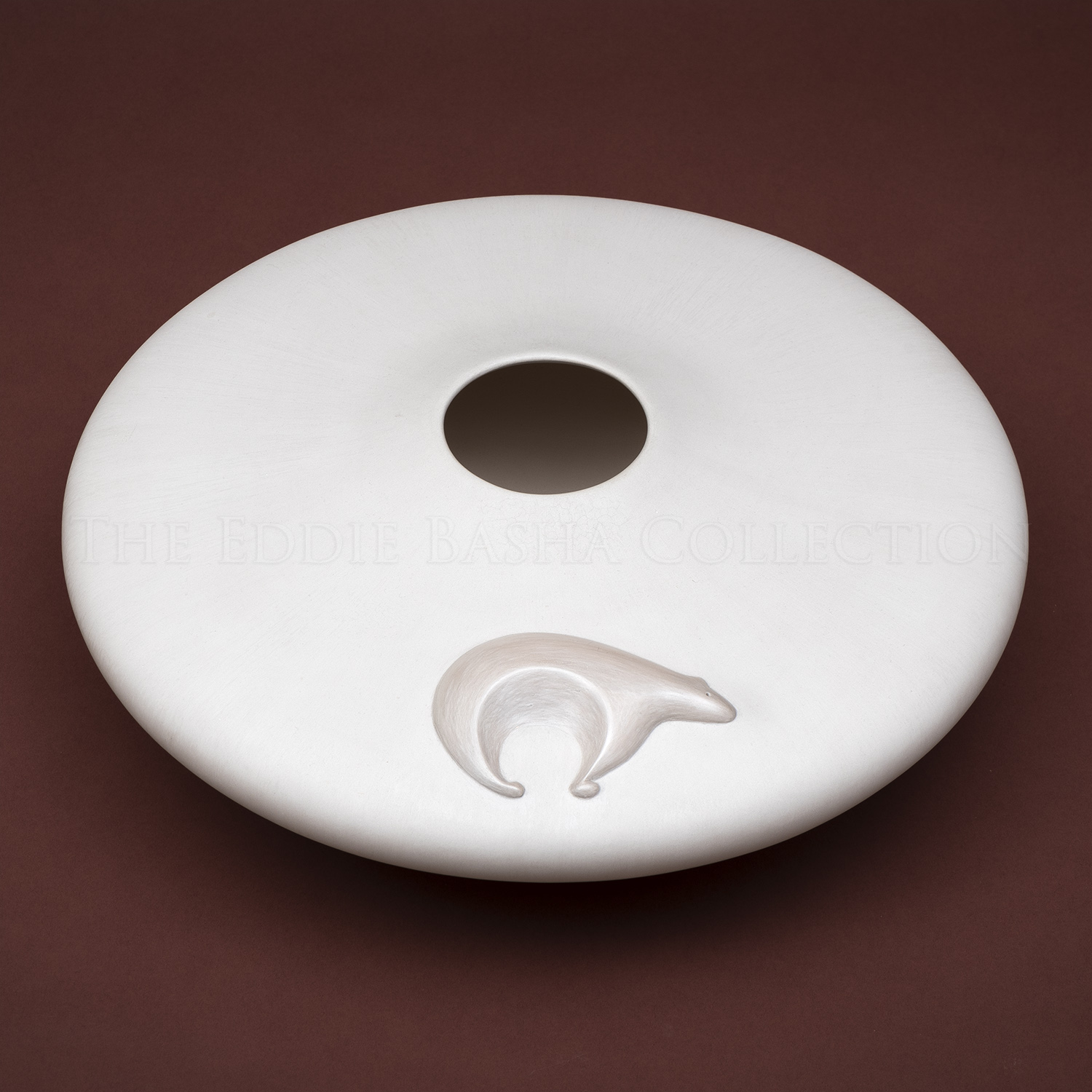
Repousse Bear Jar | Al Qöyawayma (b.1938)
Artist: American Indian Potter
Description: Clay | Dimensions: 6”h x 16”wpottery
On his website, http://alqpottery.com/about/pottery-biography/ , Al Qöyawayma shared the following:
“My style tends towards that of a minimalist. I use the repousse technique on native clay to produce pieces of pristine, fluid form, with high sculptural relief. The finish is stone polished producing the hue and shadow of high desert landscape, and softness to the tourch. I use many motifs such as ancient architecture, dancing figures, and icons such as corn, animal, and feather designs. My clays are from Hopi. Through study of our ancient Sikyatki ceramics, I’ve been able to closely reproduce an original clay. Using this clay and traditional coiling techniques allows me to construct complex, thin, lightweight forms.”
Al honed his artistic skills under the tutelage of his Aunt Polingaysi Qöyawayma, at ASU, Scottsdale Community College and Scottsdale Artist’s School. He received his B.S. in Engineering at California Polytechnic State Univery, his M.S. Engineering at University of Southern California and completed his graduate studies at both UCLA and ASU.
Al has been featured in numerous publications throughout the years and he has also received deservedly so an abundant number of awards.
Polychrome Sikyatki Jar – Bird Motif | Nathan Begaye (1958-2010)
Artist: American Indian Potter
Description: Pottery | Dimensions: 3”h x 8”dpottery
Born in Phoenix, Arizona, to a Navajo father and Hopi mother, Nathan Begaye was raised steeped in tribal tradition, culture, customs, and religious beliefs by his maternal grandparents on the Hopi Reservation at Third Mesa and Tuba City. At the early age of 10, Begaye developed an interest in pottery and held his first exhibition one year later. He continued to learn about traditional techniques and pigment recipes from both tribal communities. Upon receiving a SWAIA scholarship, he left home at 14 to study at the Institute of American Indian Arts in Santa Fe, NM. His work used traditional designs, forms, and techniques yet appeared modern. Begaye was featured in several books including “Free Spirit: The New Native American Indian Potter,” “Beyond Traditions,” and others. His pottery can be found in permanent collections of the Heard Museum and others as well as in esteemed private collections.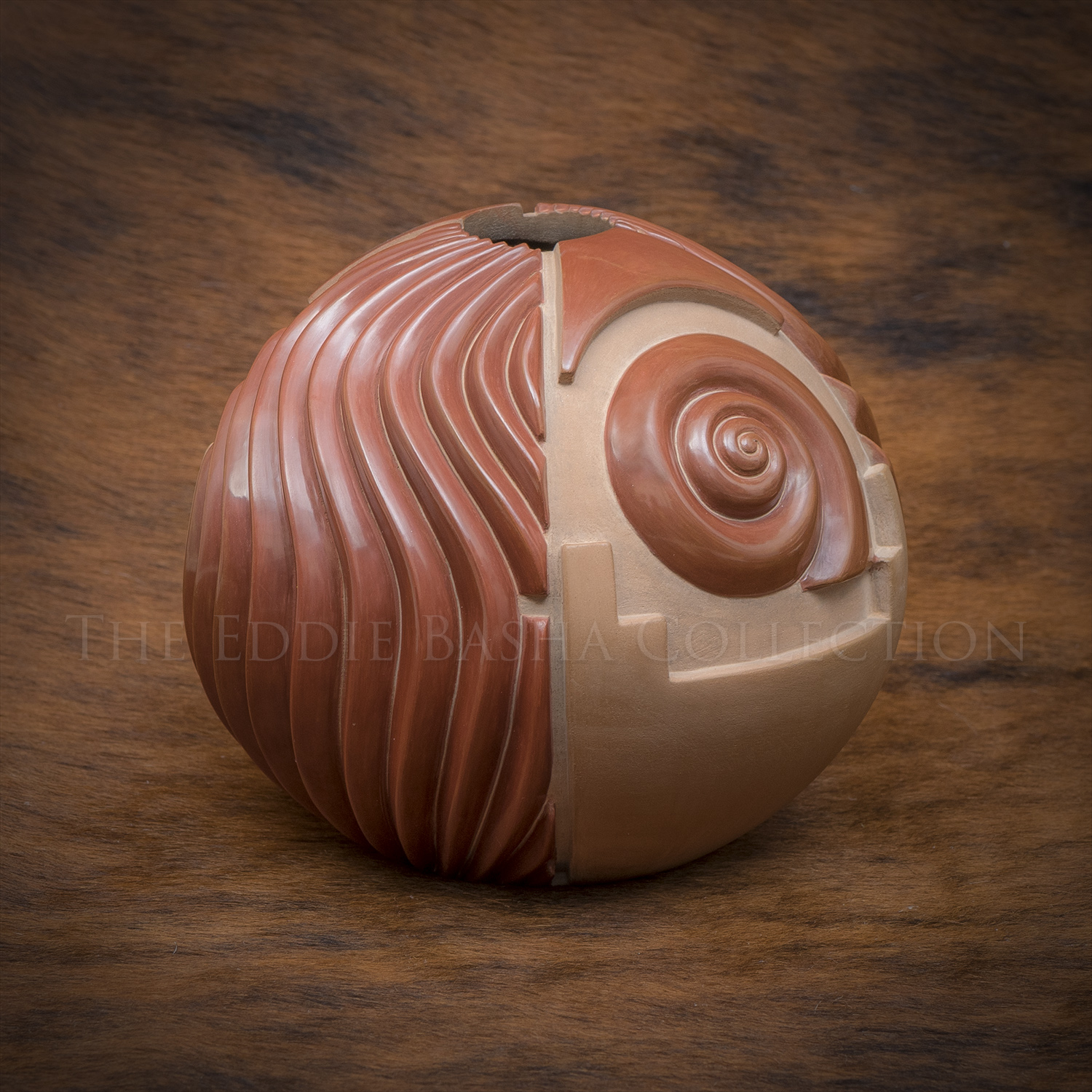
Melon Bowl | Nancy Youngblood (b.1955)
Artist: American Indian Potter
Description: Pottery | Dimensions: 5”h x 6”dpottery
On Nancy Youngblood’s website https://www.nancyyoungbloodinc.com/pottery.html , the artist shared the following about the pottery polishing process: “Polishing is a tedious stage of intense concentration, and the pot must be handled with extreme care due to its fragility before being fired. Nancy’s need for perfection of polish allows for only three ribs of a melon jar to be polished in a three-hour stint. An even all-around polish is most difficult with the S-swirl ribs. Nancy estimates that a 64-ribbed bowl will require five or six twelve-hour days to polish to her satisfaction. Her polishing stones include a smooth black stone call “Apache Tears,” which belonged to great grandmother Sarafina, and several small flat pointed stones whose shapes fit exactly into the deep ridges of her melon jars. Recessed areas and surfaces not to be polished are painted with a matte slip.”
Nancy Youngblood is a multi-award-winning potter from the Santa Clara Pueblo. Her work can be found in museums and private collections worldwide.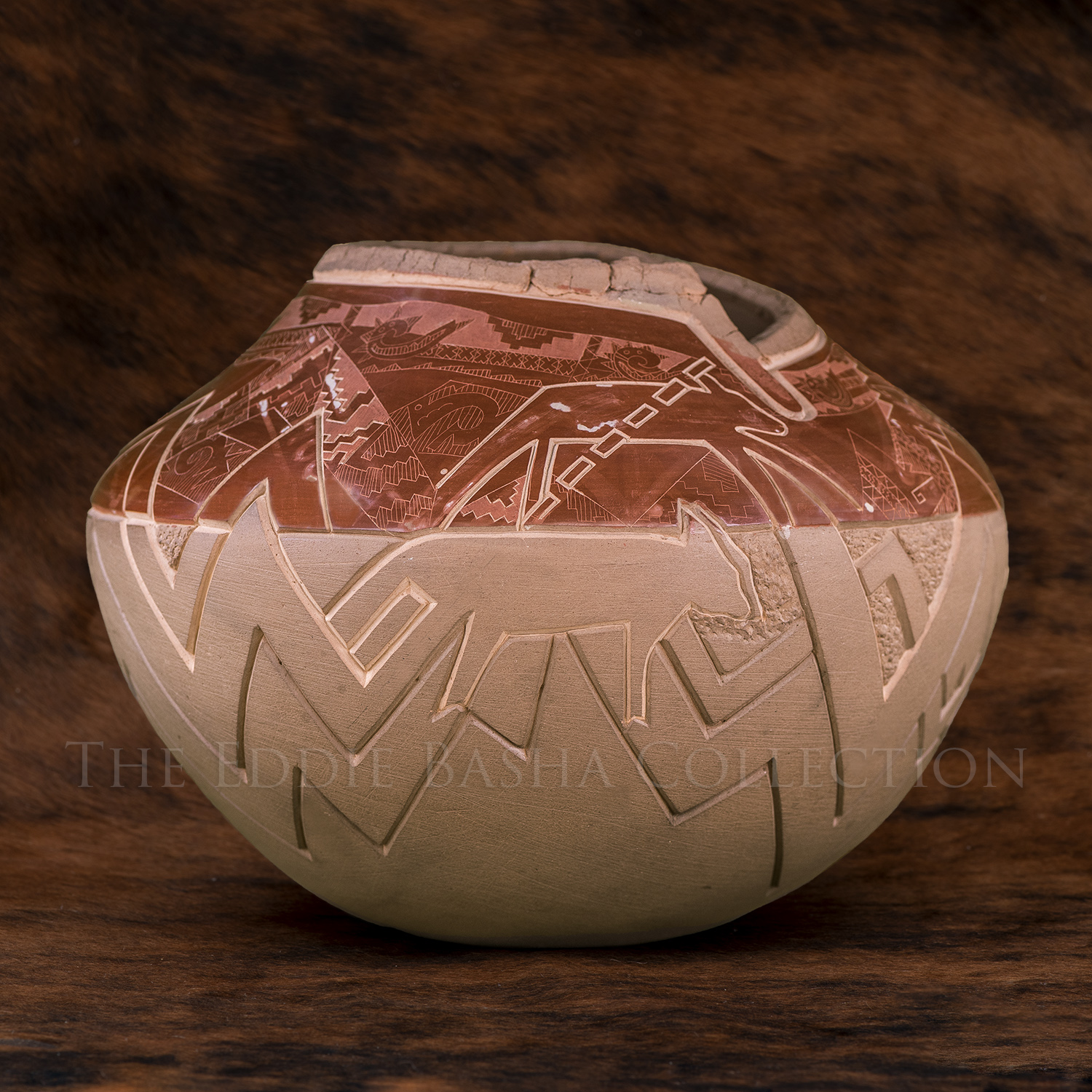
Sienna Pot | Jody Folwell (b.1942)
Artist: American Indian Potter
Description: Pottery | Dimensions: 8”h x 11”dpottery
There’s beauty in imperfection! And, most often we don’t have to look too far to find it.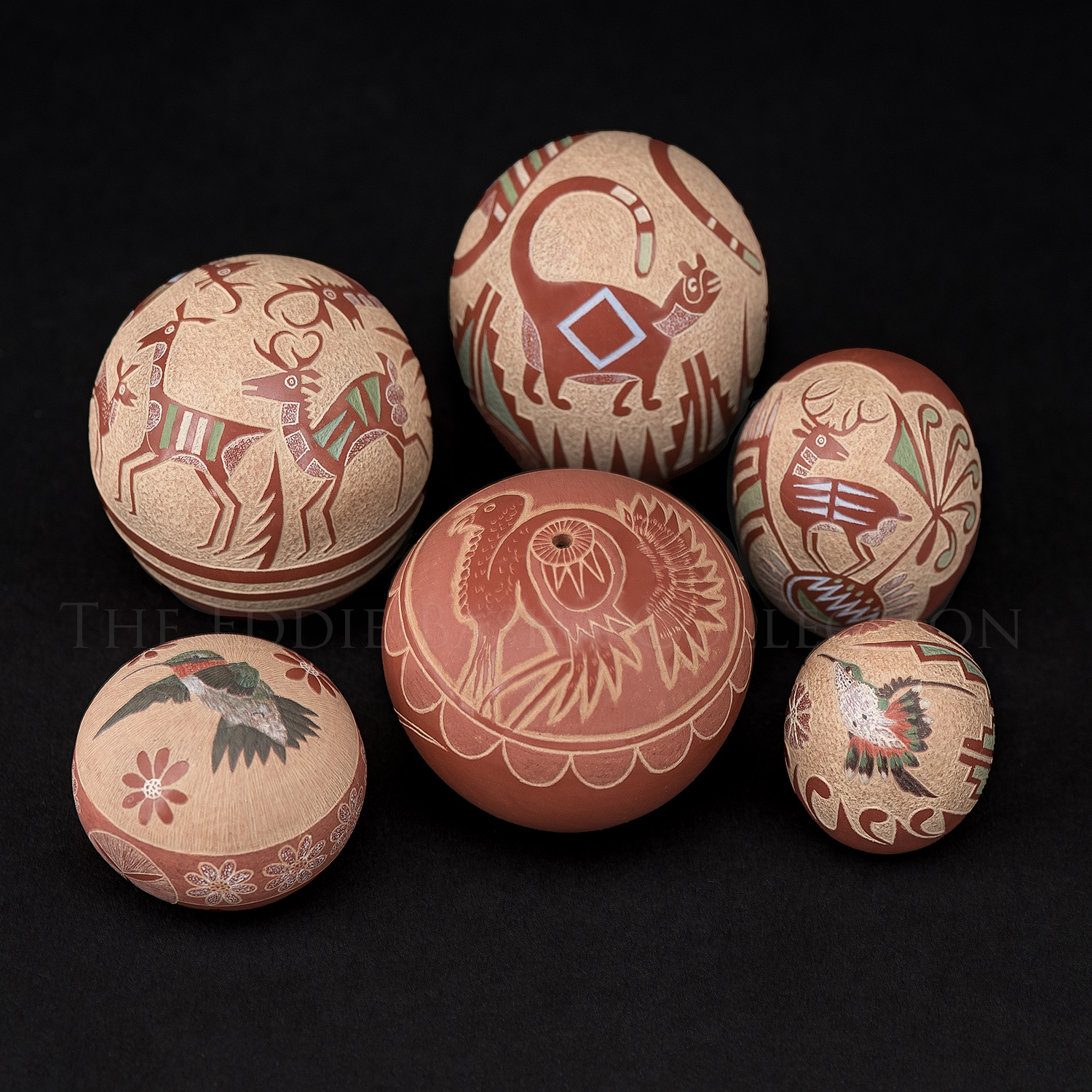
Unknown Titles | Joseph Lonewolf (1932-2014)
Artist: American Indian Potter
Description: Seed Pots | Assorted Sizes Ranging from ¾”h to 1 ½”dpottery
Joseph Lonewolf (1932-2014) was the son of noted potters Camilio and Agapita Tafoya and the brother of Grace Medicine Flower. Beginning in the early 1970's, Lonewolf revolutionized the world of Santa Clara pottery by incorporating his sgraffito (lightly etching the surface of the clay) and incised (more deeply cut into the clay) designs in his work. He won numerous awards throughout his career and his work can be found in museums worldwide. He was also featured in numerous books including "The Art of Clay" and received the prestigious New Mexico Governor's Award for Excellence in the Arts and the SWAIA Lifetime Achievement Award.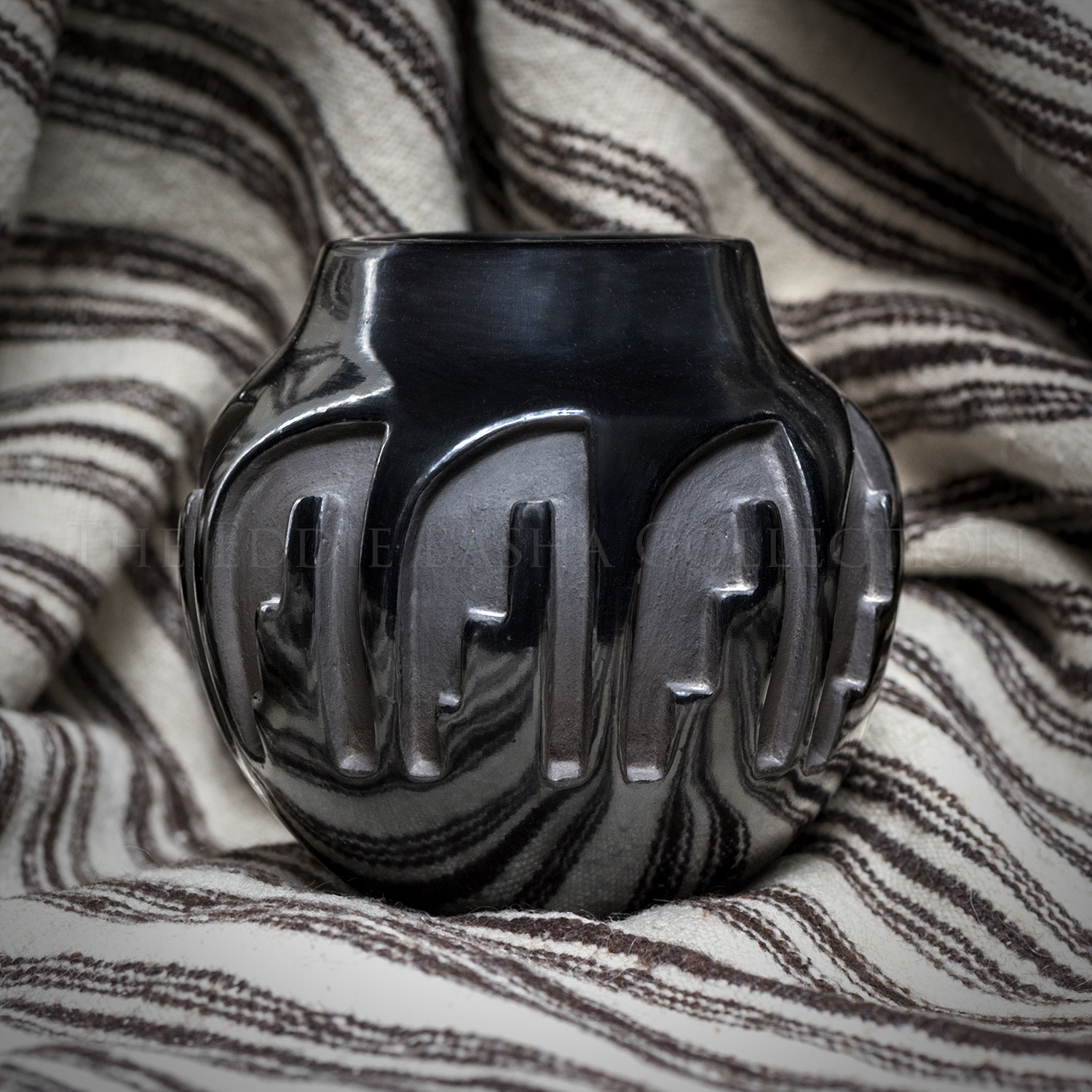
Kiva Step Jar | Anita Suazo (b.1937)
Artist: American Indian Potter
Description: Clay | Dimensions: 5”h x 5”dpottery
The deeply incised kiva step pattern of Anita Suazo’s black on black jar encircles the circumference of the piece. Culturally, the steps symbolize man’s journey from the three levels of the underworld to the upper world.
Suazo’s pedigree is impeccable. Anita’s mother, Belen “Tafoya” Tapia, was an innovator of polychrome redware pottery and began sharing her techniques with her daughter when she was just a child. Suazo has used that knowledge in her own practice and has shared it with others through various workshops and demonstrations. Her work is sought after by museums and collectors alike.
Polychrome Bowl | Steve Lucas (b.1955)
Artist: American Indian Potter
Description: Pottery | Dimensions: 10 ½” diameter x 2 ½” deeppottery
Hopi potter, Steve Lucas, is the great-great grandson of Nampeyo of Hano. While Lucas grew up around pottery, he largely learned the art from his aunt, Dextra Quotskuyva Nampeyo. Lucas’ pottery is known for its extremely thin walls. The pottery is coil built, stone polished, painted, and traditionally fired. Lucas incorporates traditional designs in his work but often adds his own style or flourish. His pottery is signed with his name and the Mudhead symbol, or Koyemsi. The signature is reflective of his Hopi-Tewa Clan. Lucas has won a number of awards for his work including Best of Show at Santa Fe Indian Market.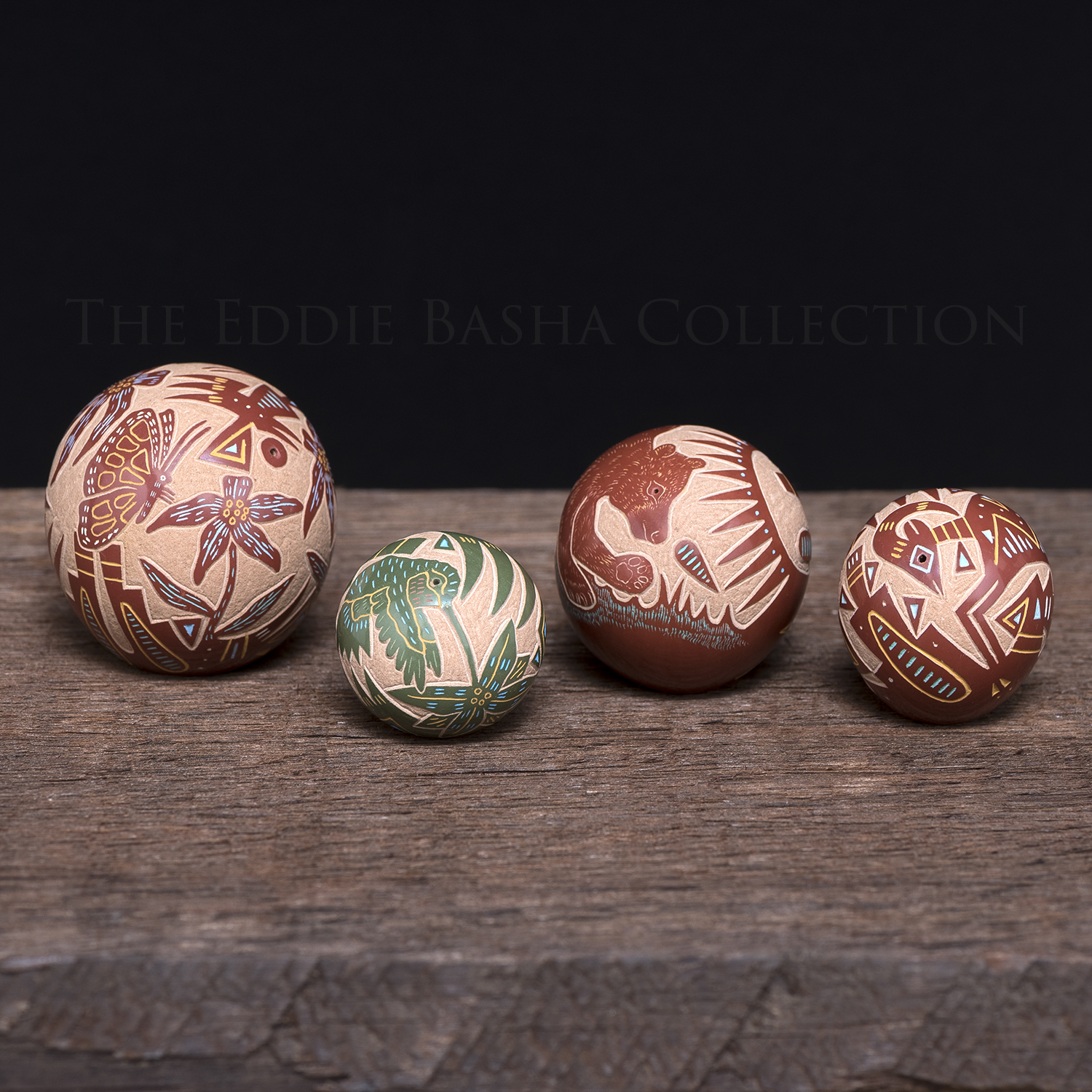
Clay Seed Pots | Ray Tafoya (1956-1994)
Artist: American Indian Potter
Description: Dimensions:pottery
Left: 2”h x 2”d
2nd from Left: 1”h x 1 ¼”d
3rd from Left: 1 ½”h x 1 ½”d
4TH from Left: 1 ¼”h x 1 ¼”d
Ray Tafoya of the famed Tafoya family of Santa Clara Pueblo potters specialized in miniature seed pots and jars and was an innovator with his use of Mimbres-like designs, patterns and larger plain surfaces with highlighted designs in a variety of clay color slips in beautiful pastel shades of yellow, blue, green and white. On such small surfaces, some only 1” in height and diameter, it is amazing to behold the exacting features of hummingbirds, rams, bears, butterflies, flowers, corn and the sun so expertly depicted.
Tafoya’s work can be found in museums, private collections (the EBC comes to mind), and galleries specializing in American Indian Fine Art Masterworks.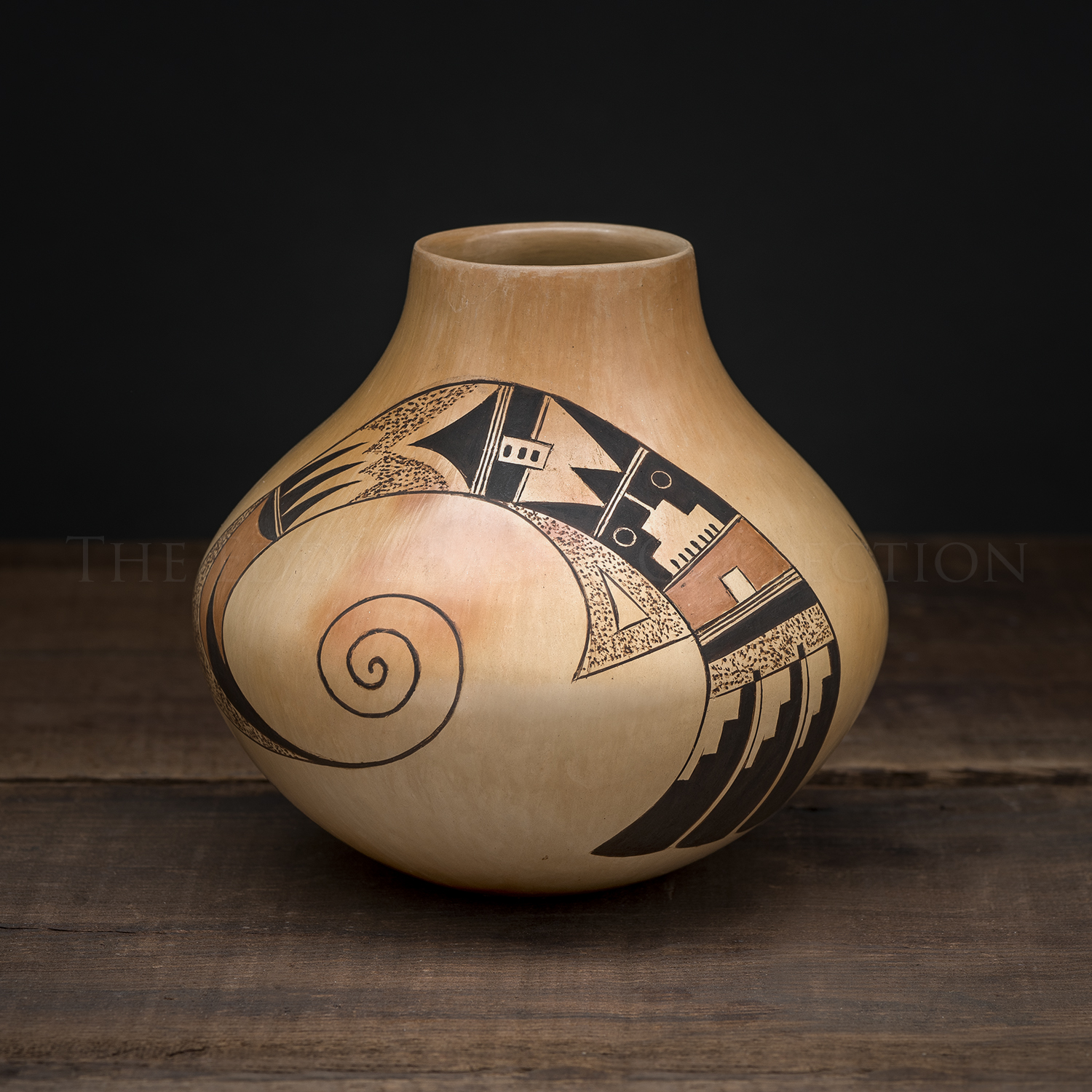
Polychrome Pot with Swirling Pueblo Motifs | Dextra Nampeyo (1928-2019)
Artist: American Indian Potter
Description: Clay | Dimensions: 6”h x 6”dpottery
Hopi artist, Dextra Nampeyo, the great granddaughter of famed potter, Nampeyo of Hano who is credited with reviving the ancient Sikyatki form of pottery, began her career utilizing many of the traditional designs favored by her mother, grandmother, and great grandmother, but in later years incorporated many of her own innovative design concepts into her work. Dextra’s pottery is known for the graceful quality of its design, its near flawless surfaces, and its detailed and striking design elements. She utilized only traditional Hopi pottery methods in hand coil construction, stone polish, paint, and open fire. Dextra passed on her techniques to a younger generation of artists and has been an inspiration to other Hopi artists, such as her son, the painter and sculptor, Dan Namingha.
In 1994, Dextra was proclaimed an “Arizona Living Treasure,” and in 1998 she received the first Arizona State Museum Lifetime Achievement Award. Her work can be found in many museums such as the Smithsonian National Museum of the American Indian, private collections and has been the subject of retrospective exhibitions at the Museum of Northern Arizona and another with a full color exhibition catalog entitled “Painted Perfection” at the Wheelwright Museum in Santa Fe.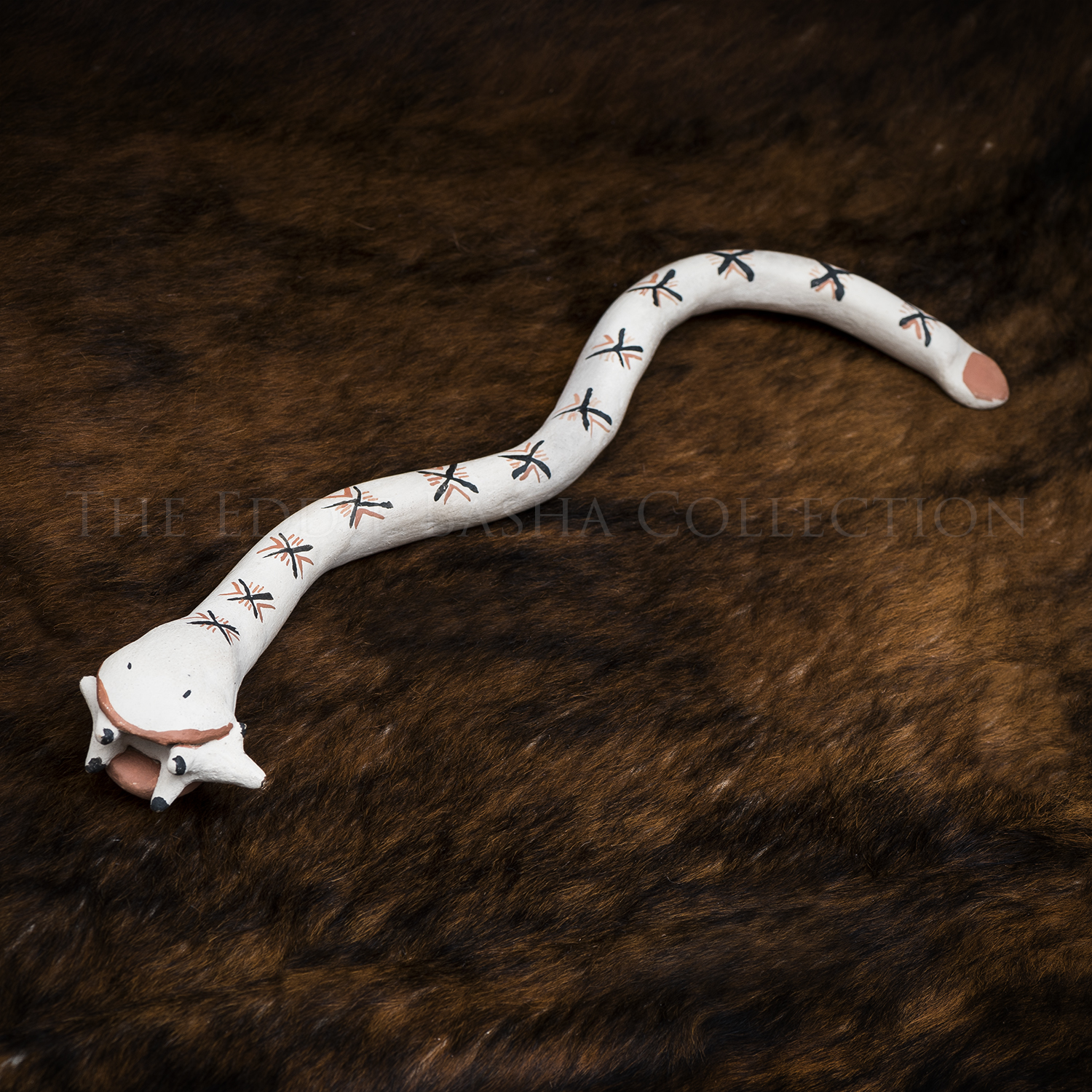
Serpent | Josephine Arquero (1928-2019)
Artist: American Indian Potter
Description: Pottery | Dimensions: 1”h x 4”w x 16”pottery
Josephine Arquero, a Cochiti Pueblo Potter, learned the construction aspects of her craft from her mother, Damacia Cordero. Josephine specialized in figurative pottery such as storytellers, nativity scenes and animals such as the serpent shown here.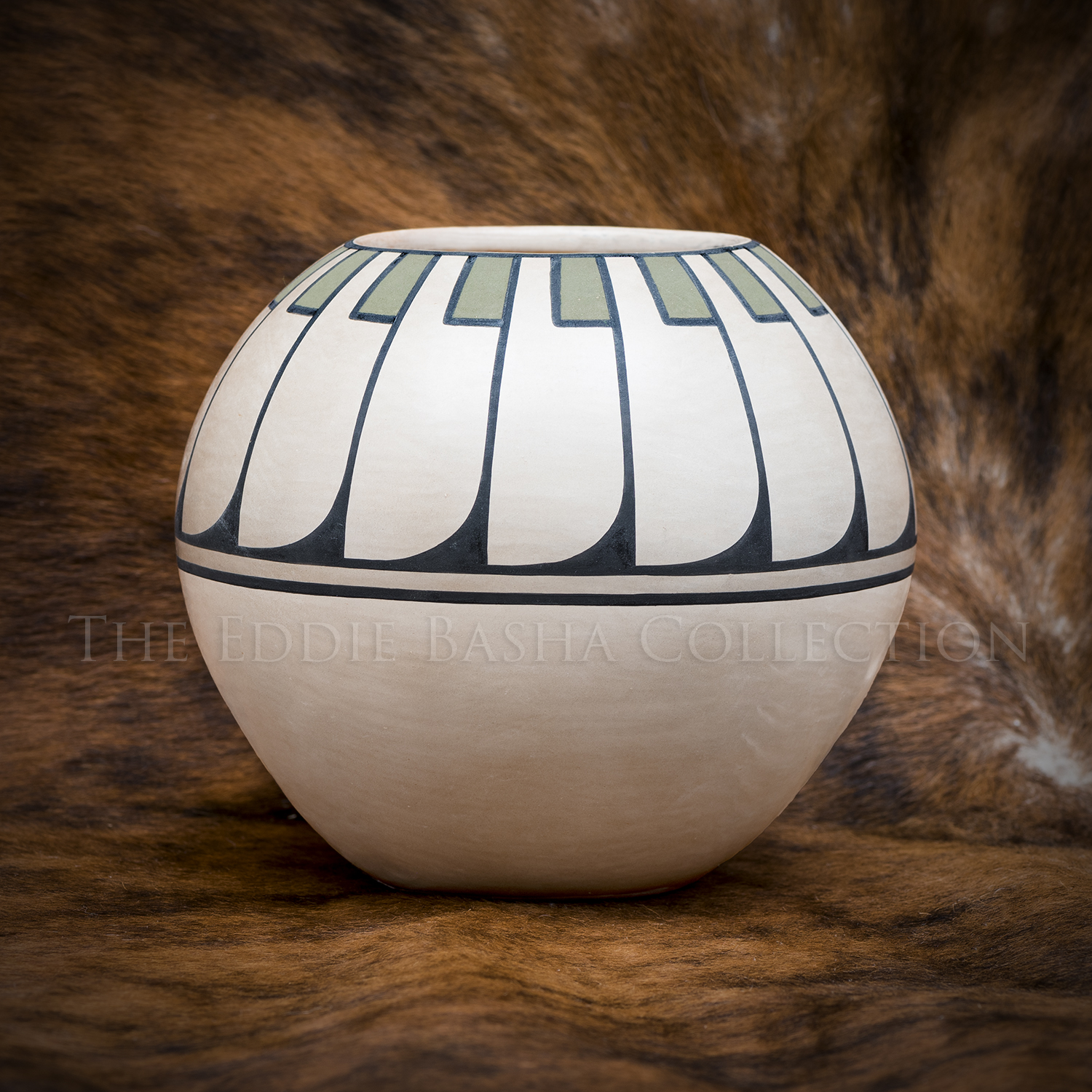
Melon Pot | Blue Corn (Crucita Calabaza) (1922-1999)
Artist: American Indian Potter
Description: Potterypottery
Blue Corn was born Crucita Calabaza at San Ildefonso Pueblo. She learned to make pottery from her mother. While attending the Santa Fe Indian School her parents passed away and she was sent to live with relatives in Southern California. Her husband, Santiago “Sandy” Calabaza was a silversmith from the Santa Domingo Pueblo. Together they settled in San Ildefonso.
Blue Corn was renowned for her polychrome pottery as well as her distinctive blackware. She became famous for reviving San Ildefonso polychrome wares and had a very long and productive career. In 1981, she received the New Mexico Governor’s Award for Excellence in the Arts and in 2008 she was posthumously given the Lifetime Achievement Award by Southwestern Association for Indian Arts - Santa Fe Indian Market.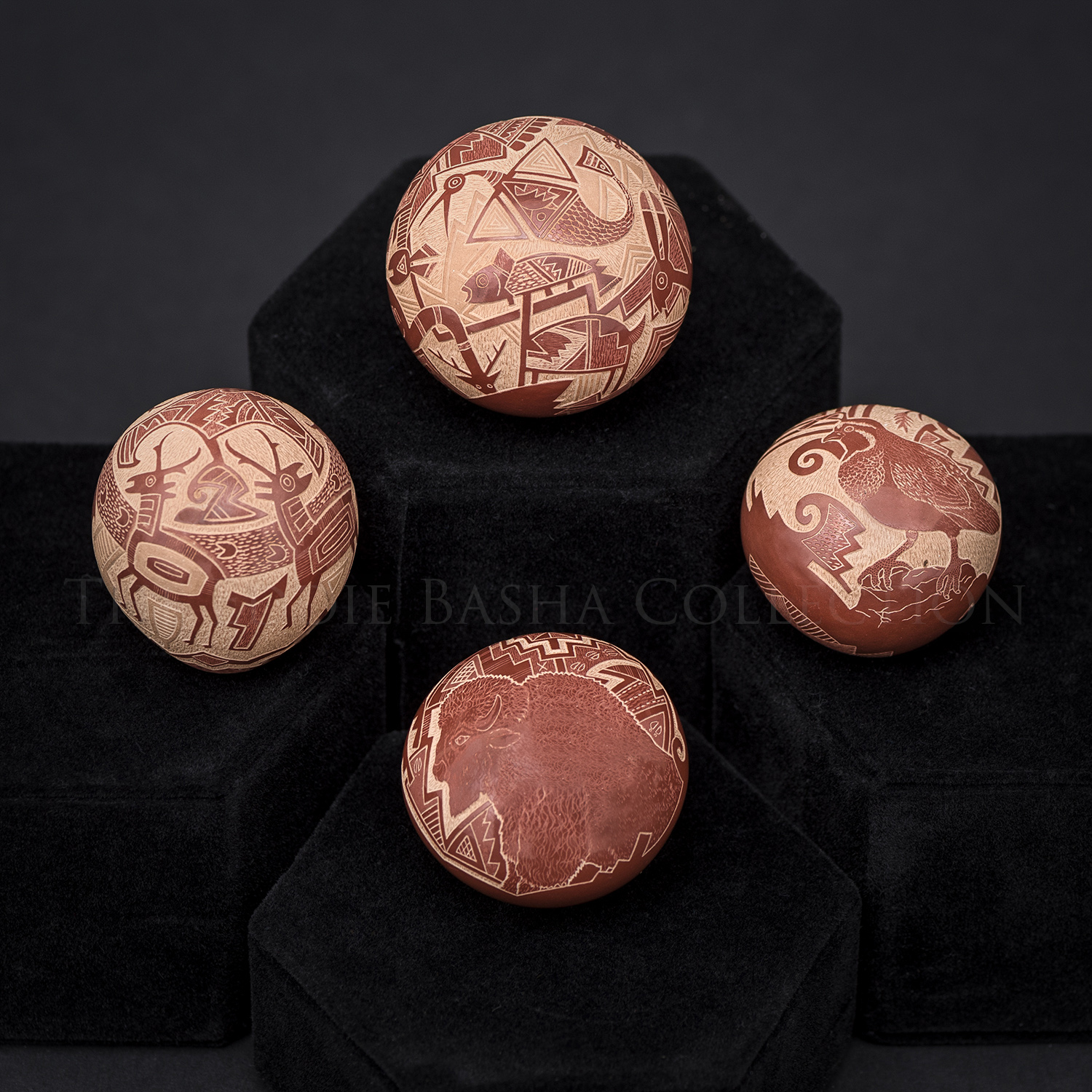
Sgraffito Seed Pots | Sue Romero; Tewa Name: “Pho-Sa-We” or “Snowflake” (b.1955)
Artist: American Indian Potter
Description: Clay | Left (Antelope): 2”h x 1 3/4”d; Top (Zoomorphic Figures): 2”h x 2”d; Right (Quail): 1 ½”h x 1 ½”d; Bottom (Bison): 1 ½”h x 2”dpottery
Actively creating pots since the 1970’s, Santa Clara potter Susan Romero learned how to etch her pottery from her father Joseph Lonewolf. She signs her pieces with her Tewa name, "Pho-Sa-We" or "Snowflake”. Her pottery is highly polished and intricately etched with detailed imagery. Her technique of scratching the design into the surface of the clay allows her to create numerous levels by contrasting the color of the clay. The polished, red and tan matte coloration became her palate for the designs.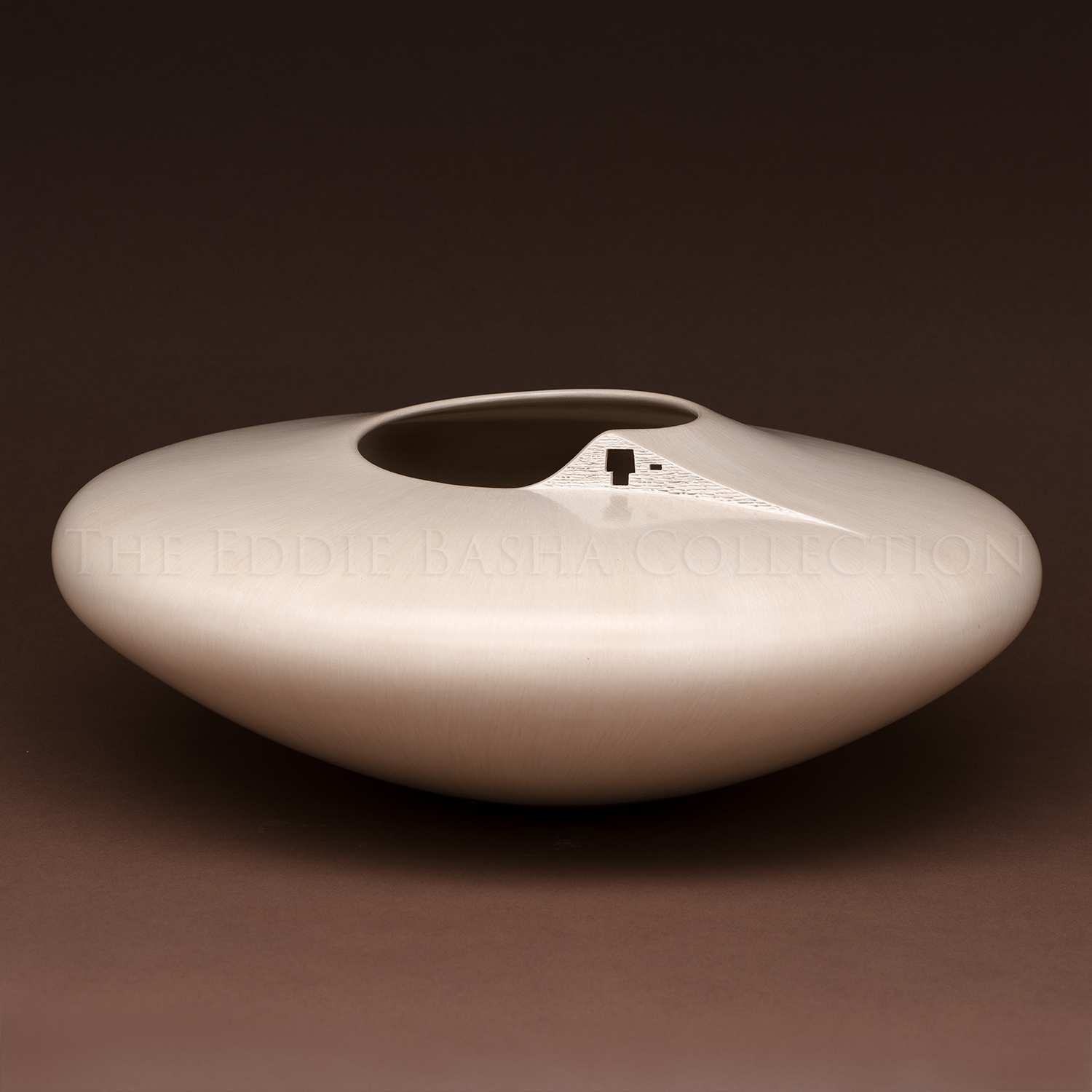
Unknown Title | Al Qöyawayma (b.1938)
Artist: American Indian Potter
Description: Pottery | Dimensions: 7”h x 18”wpottery
Spending a professional career in the aerospace industry, Al Qöyawayma is equally at ease in the worlds of science and art. His pottery is reflective of his Hopi culture with traditional designs and symbols embedded therein such as the organic rim of this piece highlighting a cliff dwelling. Its classically simple yet elegant lines are enhanced by the subtle hue reminiscent of a high desert landscape. And if you listen closely, you can hear the gentle whispers in the wind of those who once resided there.
Hopi Relief Jar | Al Qöyawayma (b.1938)
Artist: American Indian Potter
Description: Clay | Dimensions: 6”h x 6”dpottery
Al Qöyawayma’s work which has been described as “minimalist", reflects simple lines, the hues and shadows of high desert landscapes, and the softness of human touch while incorporating values of his Hopi culture.
Equally at ease in the worlds of science or art, Qöyawyma’s pottery utilizes traditional designs and symbols, but his work also has a distinctively modernistic look and feel. His pots appeal to collectors of American Indian art as well as modern sculpture.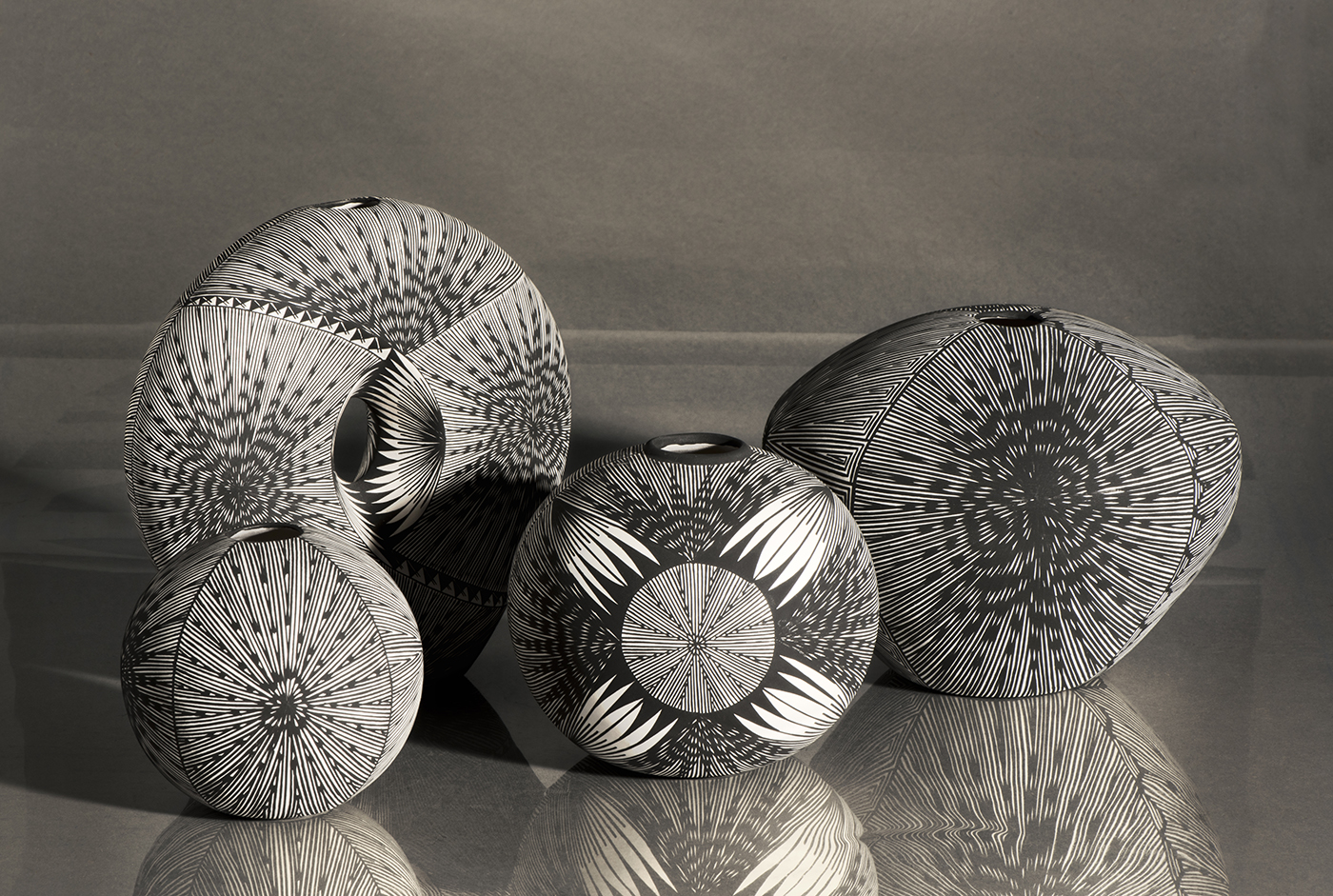
Acoma Pottery | Sanchez Family
Artist: American Indian Potter
Description: Dorothy, Jennifer & Selena Sanchez | Assorted Sizes: Tallest 7"pottery
Acoma pottery is a traditional Pueblo technique known for is intricate geometric design. Pottery by Dorothy, Jennifer & Selena Sanchez.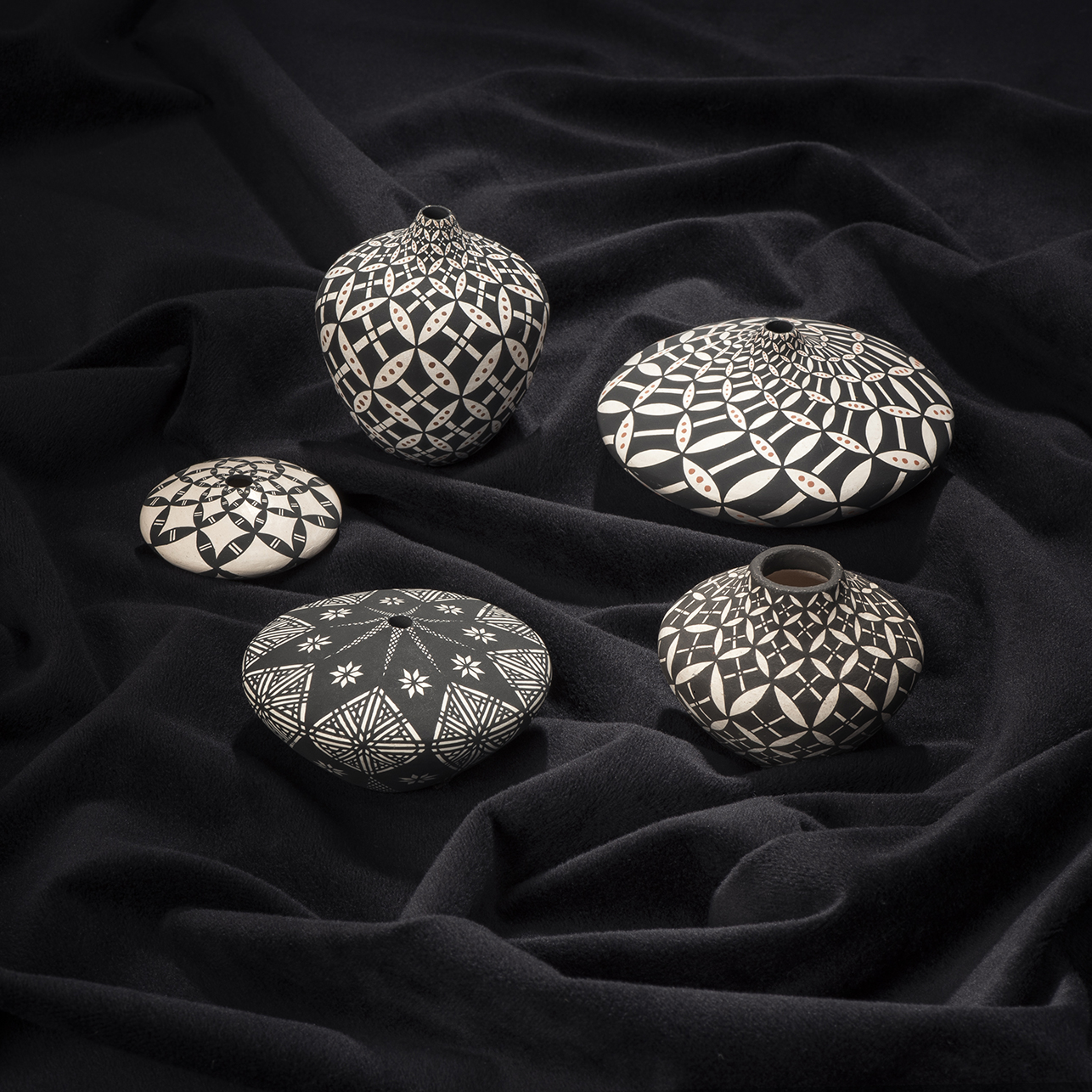
Acoma Pottery | Dorothy Torivio (b.1946)
Artist: American Indian Potter
Description: Clay | Tallest Height 3”; Largest Diameter 4”pottery
Dorothy Torivio, Acoma Pueblo, was among the first to utilize and then refine the "op-art" style in her pottery. She took classic Acoma patterns and then repeated them on a vessel, ranging the size from small to large and then small again, in accordance with the shape of the vessel. Dorothy has won numerous awards for her pottery, including Best of Pottery at the Heard Museum Guild Indian Fair & Market and was featured in books such as "The Art of Clay" and "Legacy of Generations." Utilizing repurposed yucca stalks as a brush, Dorothy paints the black on white pottery backgrounds which reverses the look of the pot.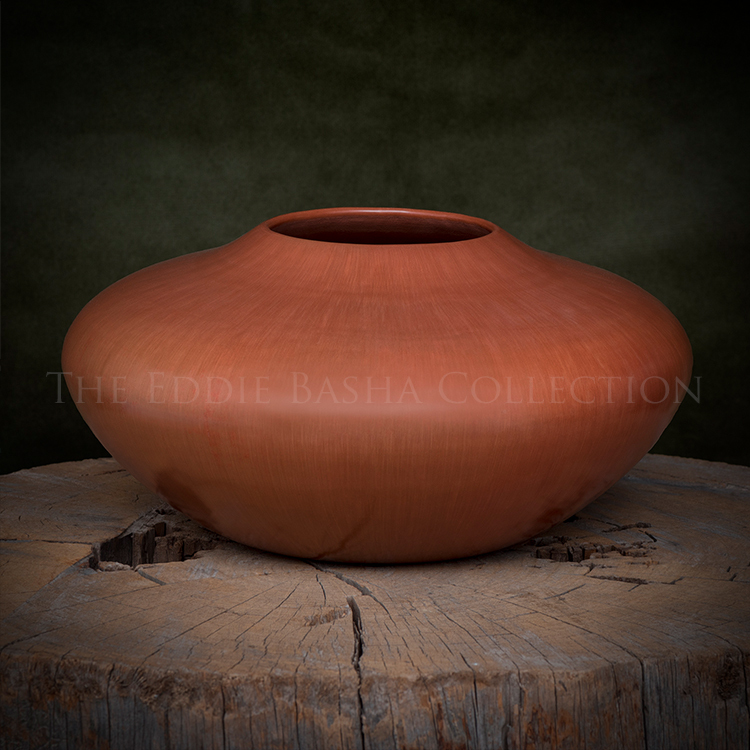
Sienna Melon Pot | Alton Komalestewa (b.1959)
Artist: American Indian Potter
Description: Clay | Dimensions: 6”h x 12”wpottery
Though Alton Komalestewa is a descendant of famed Hopi potter Nampeyo of Hano, Komalestewa learned to make pottery from his mother-in-law, Helen Shupla, of the Santa Clara Pueblo. She taught him the process of making her signature melon bowls and jars in which designs are pushed out from the inside of the pot, not carved from the outside. Often they are referred to as undulating ribs. Following the deaths of his wife and mother-in-law, both in 1989, Komalestewa returned to the Hopi where he continued to produce pottery in the Helen Shupla style, only with Hopi clay. In 2001, he returned to the Santa Clara Pueblo area and once again began using local pueblo clays and slips.
While this pot is smooth and doesn’t have the ribs often associated with his work, its meticulous shape and highly polished surface is indicative of the style Alton Komalestewa learned from his mother-in-law. Komalestewa’s pots are the only heirs to the Shupla style of melon pots.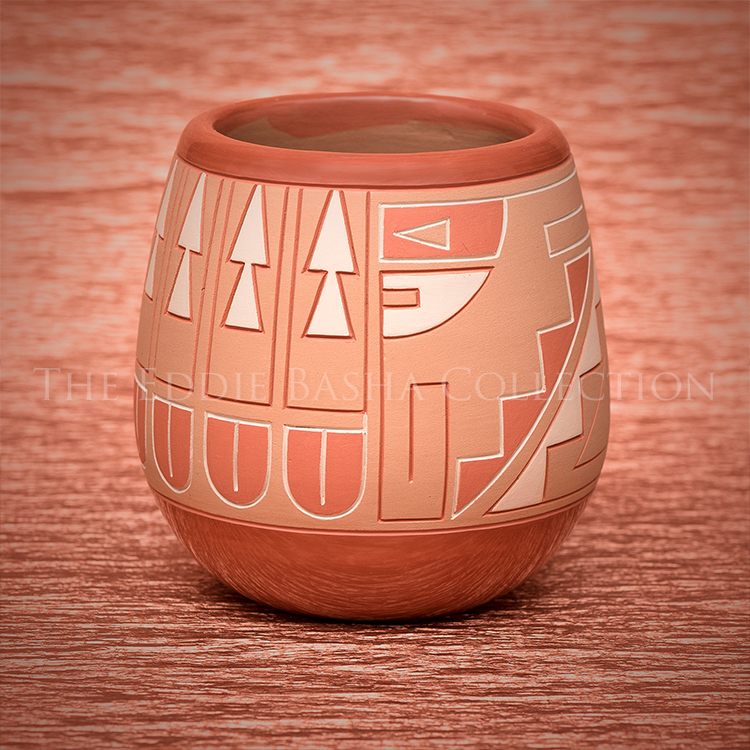
Sienna Pot | Alvin Curran (1953-1999)
Artist: American Indian Potter
Description: Pottery | Dimensions: 4”h x 4 ½”wpottery
Alvin Curran’s heritage is of the Ohkay Owingeh (San Juan Pueblo) as well as Quechan (desert people who lived along the Colorado River between Arizona and California). He began living with his maternal grandparents at the San Juan Pueblo at one year of age. As an adult, his career path led him to law enforcement and he eventually became Chief of Police until health issues forced him to leave the profession. Though he was married to potter Dolores Curran, it was his mother-in-law who encouraged him to take up pottery since there weren’t any other males in the area at the time doing so. Curran refined the traditional style of incised San Juan polychrome pottery through his own carvings and painted designs using various shades of sienna and white slips. It was his precision that garnered him numerous awards at Santa Fe Indian Market in the “carved” division even though often times he competed against potters whose work was more deeply etched and/or fully polished.
This pot is reflective of Alvin Curran’s style, work and the precision he was known for. The polychrome pot incorporates cultural and landscape references into the design and is polished at the rim and base.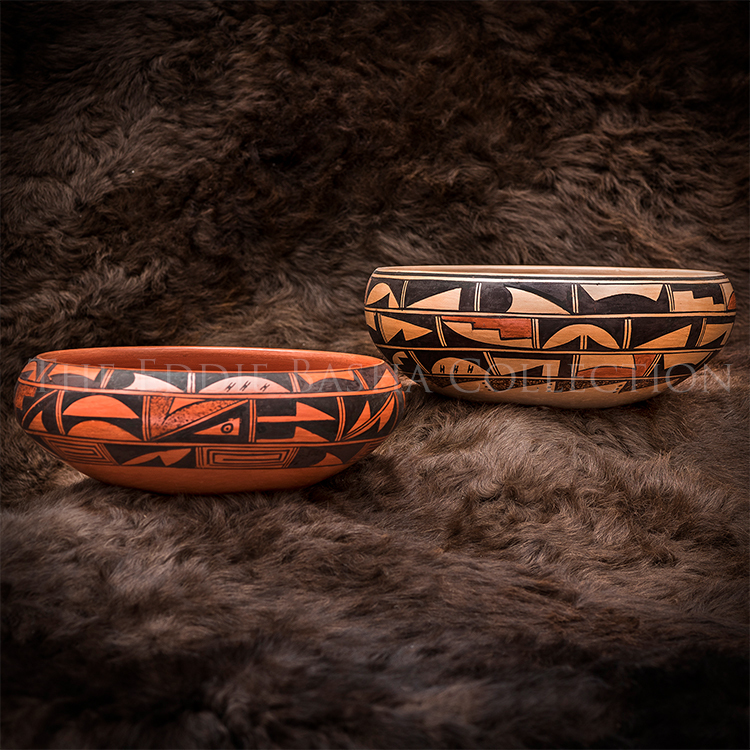
Hopi Piki Bowls | Pauline Setalla (b.1930)
Artist: American Indian Potter
Description: Pottery | Left: 3 ½”h x 10”d; Right: 4”h x 10”dpottery
Hopi potter, Pauline Setalla, was raised at Mishongnovi on Second Mesa. After marrying her husband, Justin Navasie Setalla, the couple moved to his ranch near Keams Canyon and lived in a traditional Hopi home with no electricity or other utilities, including running water. Though not easy, the couple managed to raise ten children under extremely modest circumstances.
Pauline learned the art of harvesting clay, traditional coil techniques and shaping, the firing process and creating colorful slips derived from natural materials and pigments from her mother-in-law and sister-in-law and became noted and celebrated for her wedding vases, water canteens and traditional piki bowls such as the two shown here. Two of Pauline’s daughters are also committed to the preservation of the art of traditional Hopi pottery and frequently educate others through pottery demonstrations and lectures.
Hummingbird | Ray Tafoya (1956-1994)
Artist: American Indian Potter
Description: Seed Pot | Dimensions: 2”h x 1 ½”dpottery
Ray Tafoya, Santa Clara Pueblo, was an innovator in incised pottery. While he died young, at age 38, he was known for his use of Mimbres designs as well as designs on larger plain surfaces that were highlighted by additional clay slips.
Mountain Goat | Ray Tafoya (1956-1994)
Artist: American Indian Potter
Description: Seed Pot | Dimensions: 1 ½”h x 1”dpottery
Ray Tafoya, Santa Clara Pueblo, was an innovator in incised pottery. While he died young, at age 38, he was known for his use of Mimbres designs as well as designs on larger plain surfaces that were highlighted by additional clay slips.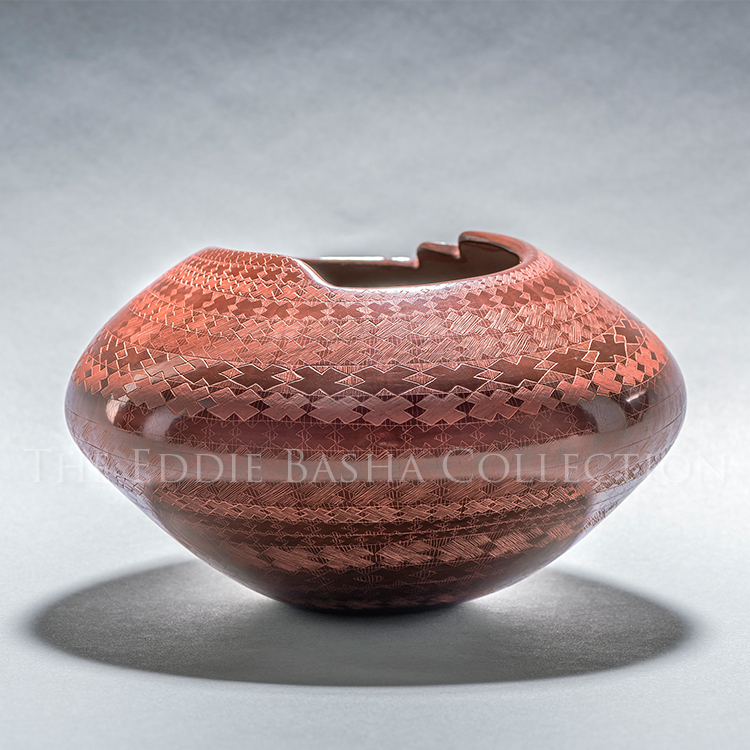
Sienna Pot | Jody Folwell (b.1942)
Artist: American Indian Potter
Description: Pottery | Dimensions: 5”h x 8”diameterpottery
Jody Folwell has long been one of the important innovators in pottery. Her revolutionary work of the 1970s changed the surface of Santa Clara Pueblo pottery with her distinctive firings, use of various clay slips and a wide variety of design subject matter incorporating traditional elements and/or non-traditional elements that reflect current world events. This highly-polished sienna pot incorporates both, the non-traditional in its sloping rim and slip varieties and the traditional in its Four Direction symbol presentation. Four, a sacred number of southwest tribes, represents north, south, east and west literally, but it is also indicative of four sacred mountains: The San Francisco Peaks (Flagstaff, AZ); Hesperus Mountain (San Juan National Forest, CO); Blanca Peak (Rocky Mountains, CO); and Mount Taylor (Cibola National Forest, NM). And it represents the four seasons, the four stages of life (birth, youth, adulthood and old age), the four elements of nature (fire, water, air and earth), the four sacred corn colors (yellow, white, blue and black), and the four sacred plants (corn, beans, squash and tobacco).
Folwell said, "I think of each piece as an artwork that has something to say on its own, a statement about life. I think of myself as being a contemporary potter and a traditionalist at the same time. Combining the two is very emotional and exciting to me."
Her art continues to evolve and each piece integrates different aspects of her artistic journey. Her work can be found in museums worldwide and has been featured in numerous books, including "The Art of Clay" and "Legacy of Generations."
Pottery | Alvina Yepa (b.1954)
Artist: American Indian Potter
Description: Left: 7”h x 8”w; Right: 6”h x 8”wpottery
Famed Jemez Pueblo potter, Alvina Yepa, won First Place and Best of Division for her sgraffito style pottery at the 1987 Santa Fe Indian Market just a few years after she began producing pottery on her own in the early eighties. However, at the age of eight she earned her stripes painting and polishing pieces for her mother, Felipita Nonche Yepa.
Sgraffito style of pottery is made by scratching the surface to reveal lower layers of contrasting color. These pots are embellished with both sgraffito and painted features such as feathers, butterflies, clouds, serpents, pueblos and horizons.
Vase with Raised Corn Maiden Embellishment | Al Qöyawayma
Artist: American Indian Potter
Description: Timeless, elegant, sensuous, perfection, sublime, ancient and yet modern - are some of the metaphors used by collectors to describe Al Qöyawayma's (otherwise referred to as Al "Q") pottery. Nothing quite like Al's pottery has ever existed before. As with Native traditions, his pottery tradition runs deep. Contemplative and studiously quite at times, at other times he is quite gregarious, especially when describing his passion for the clay and its heritage.
Al has traveled a rather circuitous path in arriving at this point in his creative life. Along that path he has acquired significant tools of modern knowledge, but at the same time maintained a profound appreciation of his cultural roots. This is sometimes a paradox to those who know him.
Thoroughly a modern man, Al is equally at ease in today's high tech and tribal worlds. He strives to maintain a balance between those two worlds.
Al credits his pottery style to his late Aunt Polingaysi Qöyawayma, better known as Elizabeth White, a diversified talent - educator, writer and potter. In 1966 while working with the clay Elizabeth said "you've got it." Al notes: "That has always stuck with me", even though at the time I
wasn't sure what I had.". By 1976 Al had entered the "Scottsdale National Indian Art Show" and as they say "the rest was history."
In the 1980's, Al showed jointly in Santa Fe with his relative Charles Loloma, to whom Al credits considerable influence and encouragement. In the highly charged markets of the 1980's Al experienced instant sellout shows. Both Charles and Elizabeth related that it was their idea to use their backgrounds as stepping stones to project beyond all Indianisms, to blend tradition with contemporary expression. And, that is part of the philosophy behind Al's pottery creations.
"My style tends towards that of a minimalist. I use the repousse' technique on native clay to produce pieces of pristine, fluid form, with high sculptural relief. The finish is stone polished producing the hue and shadow of high desert landscape, and softness to the touch. I use many motifs such as ancient architecture, dancing figures, and icons such as corn, animal and feather designs. My clays are from Hopi. Through study of
our ancient Sikyatki ceramics I've been able to closely reproduce an original clay. Using this clay and traditional coiling techniques allows me to construct complex, thin, lightweight forms."
Sikyatki - Al explains that his Coyote Clan was the sole occupant of the ancient village of Sikyatki. Their origins, language, religion and traditions were different than the Hopi we know today. Sikyatki pottery is
known for it's low shouldered forms and intricate designs. Jesse Walter Fewkes of the Smithsonian excavated Sikyatki in 1895. Fewkes stated that "...In my judgement [Sikyatki ceramic art] is superior to any pottery made
by ancient... Indians north of Mexico." With those roots it is perhaps only natural that Al's ceramic creative skills should emerge.
It is Al's grandmother, Sevenka, who passed down the families spiritual challenge: "We do not walk alone, Great Spirit walks beside us, always know this, and be grateful." Al lives by that Grace and acknowledges the Creator's hand in all parts of his life.
Seed Pots | Sylvia Naha (1951-1999)
Artist: American Indian Potter
Description: Clay | Heights Range from 3.5” - 6”pottery
Once regarded as an innovator among Hopi potters who hand-painted her white clay polished surfaces with intricate designs of lizards, turtles, hummingbirds and various crosshatch motifs, Sylvia Naha, aka “Feather Woman”, won numerous awards and honors throughout her lifetime. She signed her pieces with a painted feather insignia and an “S” for Sylvia. She learned her craft from her mother, Helen Naha. She was also the granddaughter of Paqua Naha, the first Frog Woman.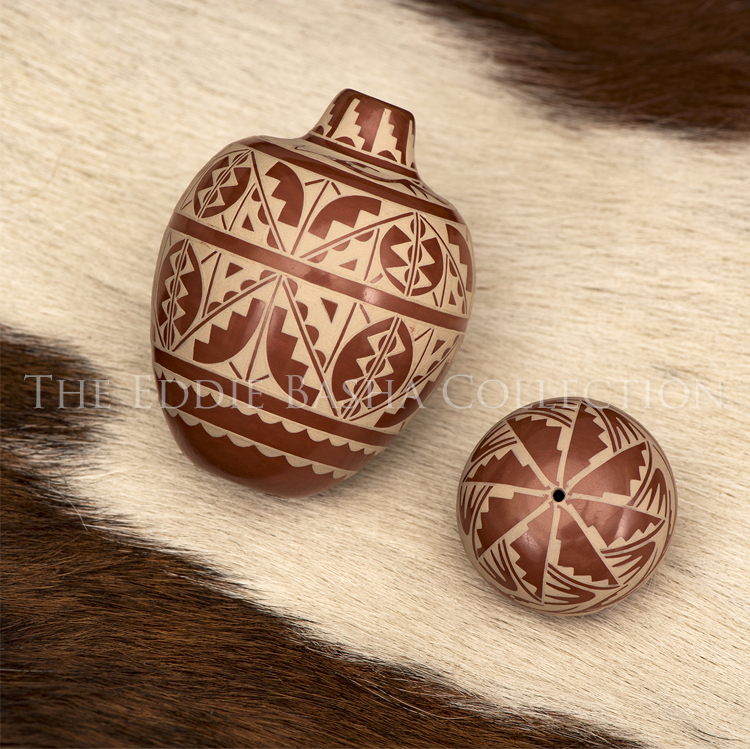
Seed Pots | Dolores Curran (b.1954)
Artist: American Indian Potter
Description: L: 2”h x 1.5”d; R: .5”h x 1”dpottery
Dolores Curran’s painted pots are typically small in size due to the intricacy of the designs and time involved in applying as many as five layers of slip to each piece. These two pots shown are small and from an early phase of her work. Her designs often include geometric shapes, feathers, birds, and water serpents. Curran’s later work is typically carved and more reflective of her late husband’s, Alvin Curran, San Juan style of pottery. This change came about largely due to the diminishing supply of the white or cream colored clay slip Curran used for painting.
Curran, along with her sister and brother, learned to make Santa Clara style pottery from their mother who, in turn, learned at the hand of her mother.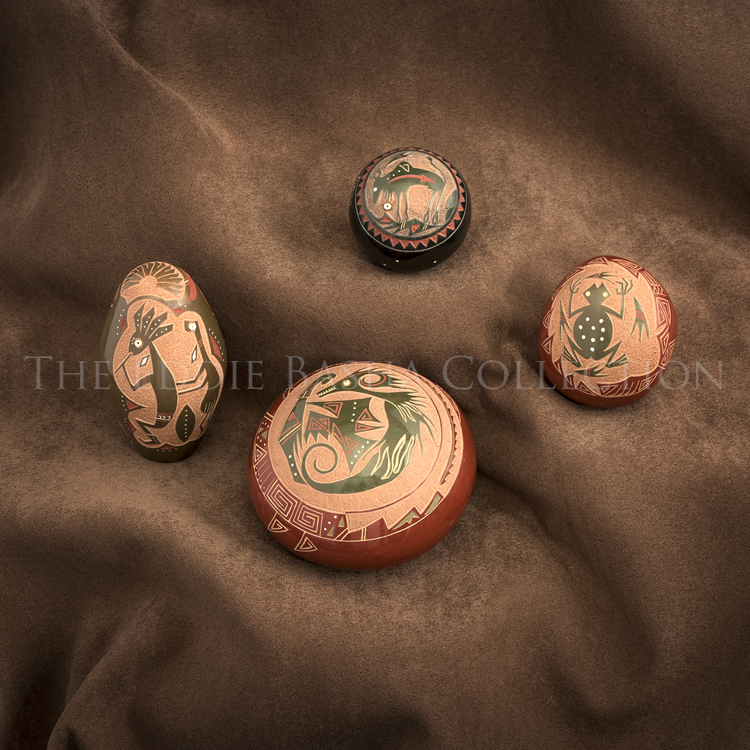
Miniature Seed Pots | Art Cody Haungooah (1943-1985)
Artist: American Indian Potter
Description: Potterypottery
The small seed pots shown here offer a varied look at the artistry of Art Cody Haungooah. They are well-appointed examples of his sgraffito style and include a number of symbols and elements representative of pueblo traditions and culture such as the avanyu (a horned or plumed serpent), spotted frog, bison and a kokopelli.
On occasion when we’re on an information quest about artworks contained in the collection to share with you, we utilize the resources of experts and friends within the greater art community. While researching the pueblo pottery of Art Cody Haungooah, the EBC happened upon this amazing blog and fascinating biography: https://kinggalleries.com/art-cody-haungooh-reflected-light-pueblo-pottery/. We highly recommend utilizing the King Galleries website which has vast amounts of biographical potter information. And, they can also help if you’re in the market for a pot or two or have an educational interest in the genre.
Pottery Vignette
Artist: American Indian Potter
pottery
 Polychrome Sikyatki Style Pottery | Dimensions: 4”h x 7”diameter
Polychrome Sikyatki Style Pottery | Dimensions: 4”h x 7”diameter Steve Lucas’ pottery practice is centered
upon his respect and admiration for traditional Hopi pottery-making processes but with reinterpreted, contemporary design elements based upon the ancient sikyátki style. This bowl features repeated geometric shapes repeated in each quarter.
Four Feathers Bowl | Steve Lucas (b.1955)
Artist: American Indian Potter
Description:
Polychrome Sikyatki Style Pottery | Dimensions: 4”h x 7”diameter
Steve Lucas’ pottery practice is centered
upon his respect and admiration for traditional Hopi pottery-making processes but with reinterpreted, contemporary design elements based upon the ancient sikyátki style. This bowl features repeated geometric shapes repeated in each quarter.
potterySteve Lucas’ pottery practice is centered
upon his respect and admiration for traditional Hopi pottery-making processes but with reinterpreted, contemporary design elements based upon the ancient sikyátki style. This bowl features repeated geometric shapes repeated in each quarter.
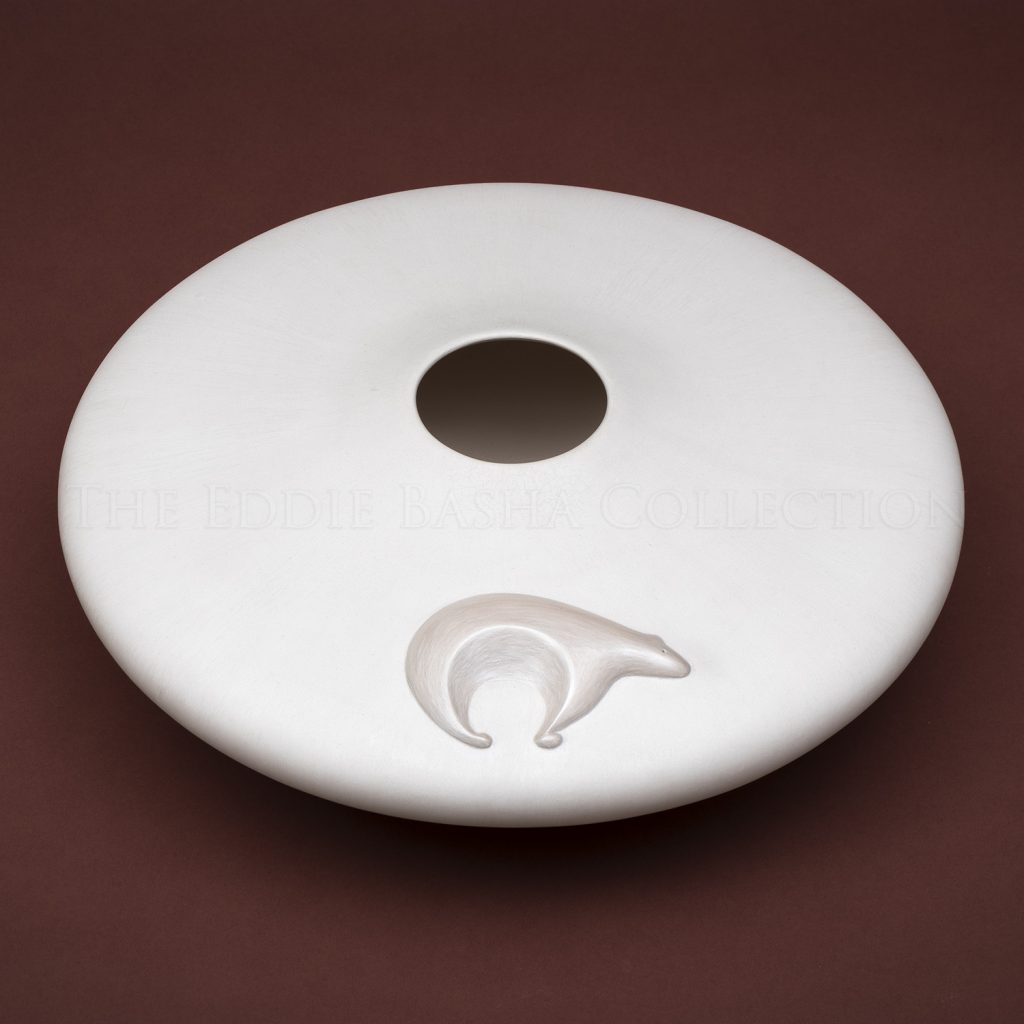 Clay | Dimensions: 6”h x 16”w
Clay | Dimensions: 6”h x 16”wOn his website, http://alqpottery.com/about/pottery-biography/ , Al Qöyawayma shared the following:
“My style tends towards that of a minimalist. I use the repousse technique on native clay to produce pieces of pristine, fluid form, with high sculptural relief. The finish is stone polished producing the hue and shadow of high desert landscape, and softness to the tourch. I use many motifs such as ancient architecture, dancing figures, and icons such as corn, animal, and feather designs. My clays are from Hopi. Through study of our ancient Sikyatki ceramics, I’ve been able to closely reproduce an original clay. Using this clay and traditional coiling techniques allows me to construct complex, thin, lightweight forms.”
Al honed his artistic skills under the tutelage of his Aunt Polingaysi Qöyawayma, at ASU, Scottsdale Community College and Scottsdale Artist’s School. He received his B.S. in Engineering at California Polytechnic State Univery, his M.S. Engineering at University of Southern California and completed his graduate studies at both UCLA and ASU.
Al has been featured in numerous publications throughout the years and he has also received deservedly so an abundant number of awards.
Repousse Bear Jar | Al Qöyawayma (b.1938)
Artist: American Indian Potter
Description:
Clay | Dimensions: 6”h x 16”w
On his website, http://alqpottery.com/about/pottery-biography/ , Al Qöyawayma shared the following:
“My style tends towards that of a minimalist. I use the repousse technique on native clay to produce pieces of pristine, fluid form, with high sculptural relief. The finish is stone polished producing the hue and shadow of high desert landscape, and softness to the tourch. I use many motifs such as ancient architecture, dancing figures, and icons such as corn, animal, and feather designs. My clays are from Hopi. Through study of our ancient Sikyatki ceramics, I’ve been able to closely reproduce an original clay. Using this clay and traditional coiling techniques allows me to construct complex, thin, lightweight forms.”
Al honed his artistic skills under the tutelage of his Aunt Polingaysi Qöyawayma, at ASU, Scottsdale Community College and Scottsdale Artist’s School. He received his B.S. in Engineering at California Polytechnic State Univery, his M.S. Engineering at University of Southern California and completed his graduate studies at both UCLA and ASU.
Al has been featured in numerous publications throughout the years and he has also received deservedly so an abundant number of awards.
potteryOn his website, http://alqpottery.com/about/pottery-biography/ , Al Qöyawayma shared the following:
“My style tends towards that of a minimalist. I use the repousse technique on native clay to produce pieces of pristine, fluid form, with high sculptural relief. The finish is stone polished producing the hue and shadow of high desert landscape, and softness to the tourch. I use many motifs such as ancient architecture, dancing figures, and icons such as corn, animal, and feather designs. My clays are from Hopi. Through study of our ancient Sikyatki ceramics, I’ve been able to closely reproduce an original clay. Using this clay and traditional coiling techniques allows me to construct complex, thin, lightweight forms.”
Al honed his artistic skills under the tutelage of his Aunt Polingaysi Qöyawayma, at ASU, Scottsdale Community College and Scottsdale Artist’s School. He received his B.S. in Engineering at California Polytechnic State Univery, his M.S. Engineering at University of Southern California and completed his graduate studies at both UCLA and ASU.
Al has been featured in numerous publications throughout the years and he has also received deservedly so an abundant number of awards.
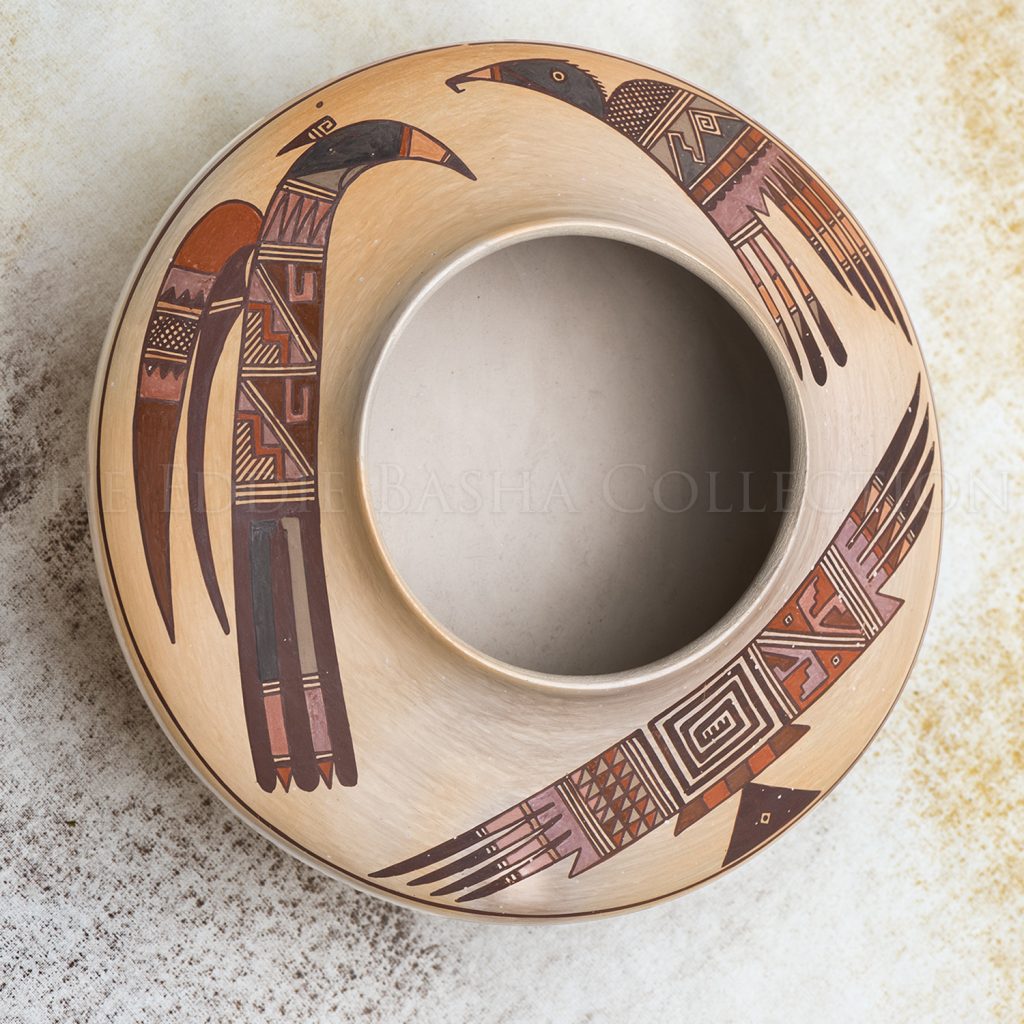 Pottery | Dimensions: 3”h x 8”d
Pottery | Dimensions: 3”h x 8”dBorn in Phoenix, Arizona, to a Navajo father and Hopi mother, Nathan Begaye was raised steeped in tribal tradition, culture, customs, and religious beliefs by his maternal grandparents on the Hopi Reservation at Third Mesa and Tuba City. At the early age of 10, Begaye developed an interest in pottery and held his first exhibition one year later. He continued to learn about traditional techniques and pigment recipes from both tribal communities. Upon receiving a SWAIA scholarship, he left home at 14 to study at the Institute of American Indian Arts in Santa Fe, NM. His work used traditional designs, forms, and techniques yet appeared modern. Begaye was featured in several books including “Free Spirit: The New Native American Indian Potter,” “Beyond Traditions,” and others. His pottery can be found in permanent collections of the Heard Museum and others as well as in esteemed private collections.
Polychrome Sikyatki Jar – Bird Motif | Nathan Begaye (1958-2010)
Artist: American Indian Potter
Description:
Pottery | Dimensions: 3”h x 8”d
Born in Phoenix, Arizona, to a Navajo father and Hopi mother, Nathan Begaye was raised steeped in tribal tradition, culture, customs, and religious beliefs by his maternal grandparents on the Hopi Reservation at Third Mesa and Tuba City. At the early age of 10, Begaye developed an interest in pottery and held his first exhibition one year later. He continued to learn about traditional techniques and pigment recipes from both tribal communities. Upon receiving a SWAIA scholarship, he left home at 14 to study at the Institute of American Indian Arts in Santa Fe, NM. His work used traditional designs, forms, and techniques yet appeared modern. Begaye was featured in several books including “Free Spirit: The New Native American Indian Potter,” “Beyond Traditions,” and others. His pottery can be found in permanent collections of the Heard Museum and others as well as in esteemed private collections.
potteryBorn in Phoenix, Arizona, to a Navajo father and Hopi mother, Nathan Begaye was raised steeped in tribal tradition, culture, customs, and religious beliefs by his maternal grandparents on the Hopi Reservation at Third Mesa and Tuba City. At the early age of 10, Begaye developed an interest in pottery and held his first exhibition one year later. He continued to learn about traditional techniques and pigment recipes from both tribal communities. Upon receiving a SWAIA scholarship, he left home at 14 to study at the Institute of American Indian Arts in Santa Fe, NM. His work used traditional designs, forms, and techniques yet appeared modern. Begaye was featured in several books including “Free Spirit: The New Native American Indian Potter,” “Beyond Traditions,” and others. His pottery can be found in permanent collections of the Heard Museum and others as well as in esteemed private collections.
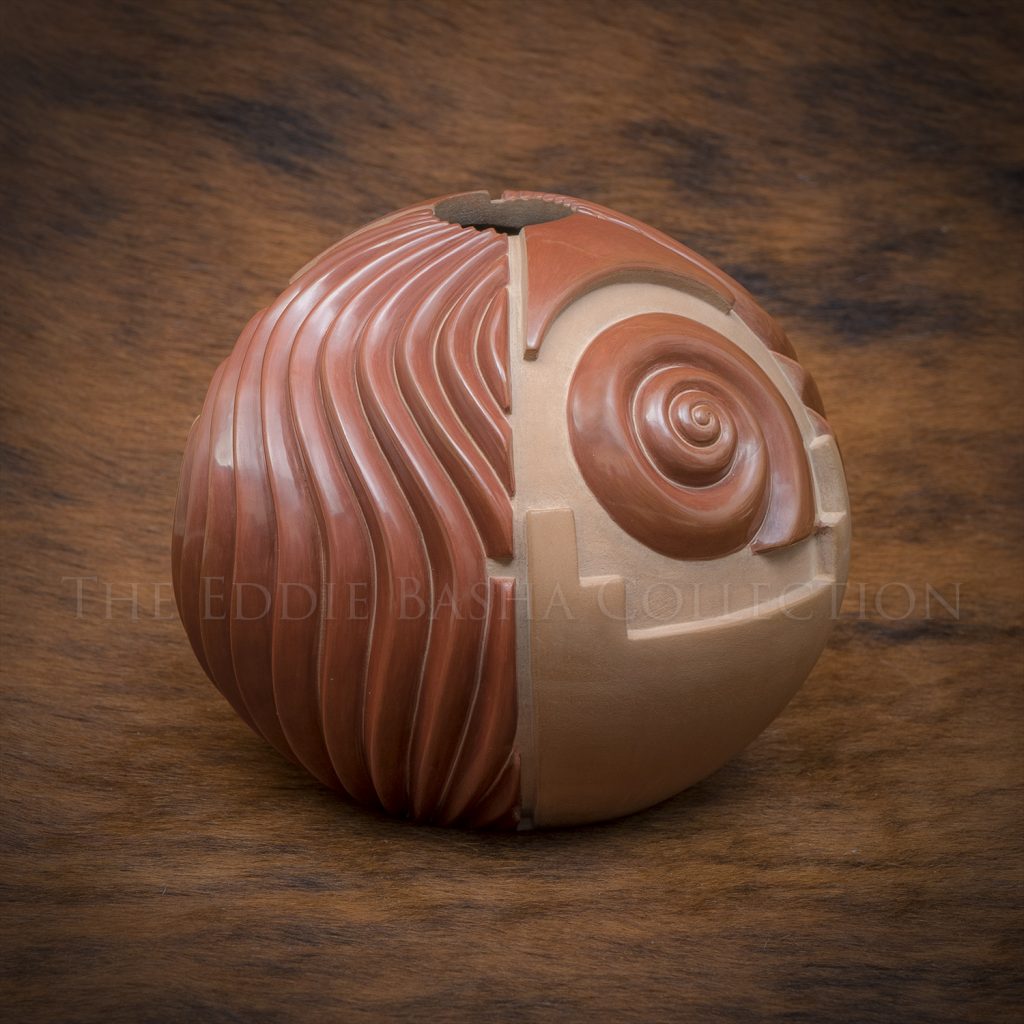 Pottery | Dimensions: 5”h x 6”d
Pottery | Dimensions: 5”h x 6”dOn Nancy Youngblood’s website https://www.nancyyoungbloodinc.com/pottery.html , the artist shared the following about the pottery polishing process: “Polishing is a tedious stage of intense concentration, and the pot must be handled with extreme care due to its fragility before being fired. Nancy’s need for perfection of polish allows for only three ribs of a melon jar to be polished in a three-hour stint. An even all-around polish is most difficult with the S-swirl ribs. Nancy estimates that a 64-ribbed bowl will require five or six twelve-hour days to polish to her satisfaction. Her polishing stones include a smooth black stone call “Apache Tears,” which belonged to great grandmother Sarafina, and several small flat pointed stones whose shapes fit exactly into the deep ridges of her melon jars. Recessed areas and surfaces not to be polished are painted with a matte slip.”
Nancy Youngblood is a multi-award-winning potter from the Santa Clara Pueblo. Her work can be found in museums and private collections worldwide.
Melon Bowl | Nancy Youngblood (b.1955)
Artist: American Indian Potter
Description:
Pottery | Dimensions: 5”h x 6”d
On Nancy Youngblood’s website https://www.nancyyoungbloodinc.com/pottery.html , the artist shared the following about the pottery polishing process: “Polishing is a tedious stage of intense concentration, and the pot must be handled with extreme care due to its fragility before being fired. Nancy’s need for perfection of polish allows for only three ribs of a melon jar to be polished in a three-hour stint. An even all-around polish is most difficult with the S-swirl ribs. Nancy estimates that a 64-ribbed bowl will require five or six twelve-hour days to polish to her satisfaction. Her polishing stones include a smooth black stone call “Apache Tears,” which belonged to great grandmother Sarafina, and several small flat pointed stones whose shapes fit exactly into the deep ridges of her melon jars. Recessed areas and surfaces not to be polished are painted with a matte slip.”
Nancy Youngblood is a multi-award-winning potter from the Santa Clara Pueblo. Her work can be found in museums and private collections worldwide.
potteryOn Nancy Youngblood’s website https://www.nancyyoungbloodinc.com/pottery.html , the artist shared the following about the pottery polishing process: “Polishing is a tedious stage of intense concentration, and the pot must be handled with extreme care due to its fragility before being fired. Nancy’s need for perfection of polish allows for only three ribs of a melon jar to be polished in a three-hour stint. An even all-around polish is most difficult with the S-swirl ribs. Nancy estimates that a 64-ribbed bowl will require five or six twelve-hour days to polish to her satisfaction. Her polishing stones include a smooth black stone call “Apache Tears,” which belonged to great grandmother Sarafina, and several small flat pointed stones whose shapes fit exactly into the deep ridges of her melon jars. Recessed areas and surfaces not to be polished are painted with a matte slip.”
Nancy Youngblood is a multi-award-winning potter from the Santa Clara Pueblo. Her work can be found in museums and private collections worldwide.
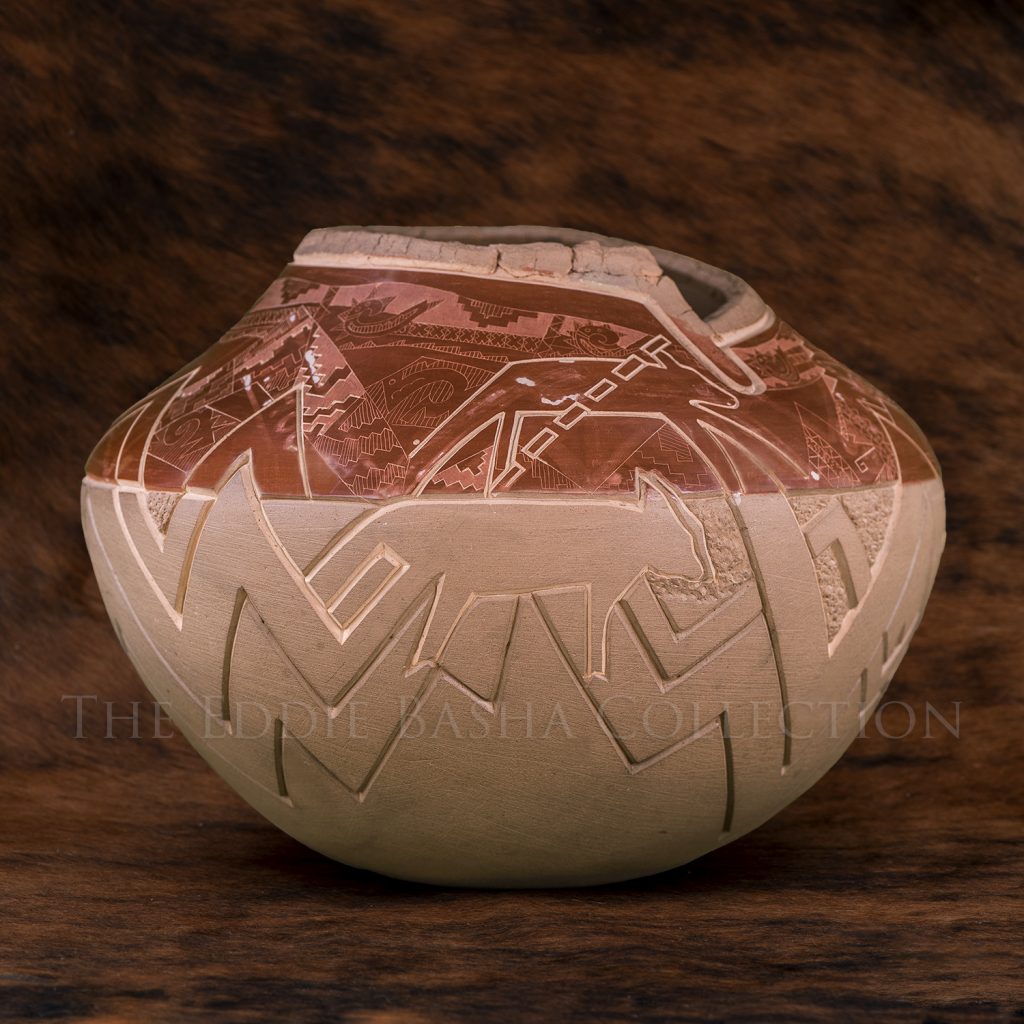 Pottery | Dimensions: 8”h x 11”d
Pottery | Dimensions: 8”h x 11”dThere’s beauty in imperfection! And, most often we don’t have to look too far to find it.
Sienna Pot | Jody Folwell (b.1942)
Artist: American Indian Potter
Description:
Pottery | Dimensions: 8”h x 11”d
There’s beauty in imperfection! And, most often we don’t have to look too far to find it.
potteryThere’s beauty in imperfection! And, most often we don’t have to look too far to find it.
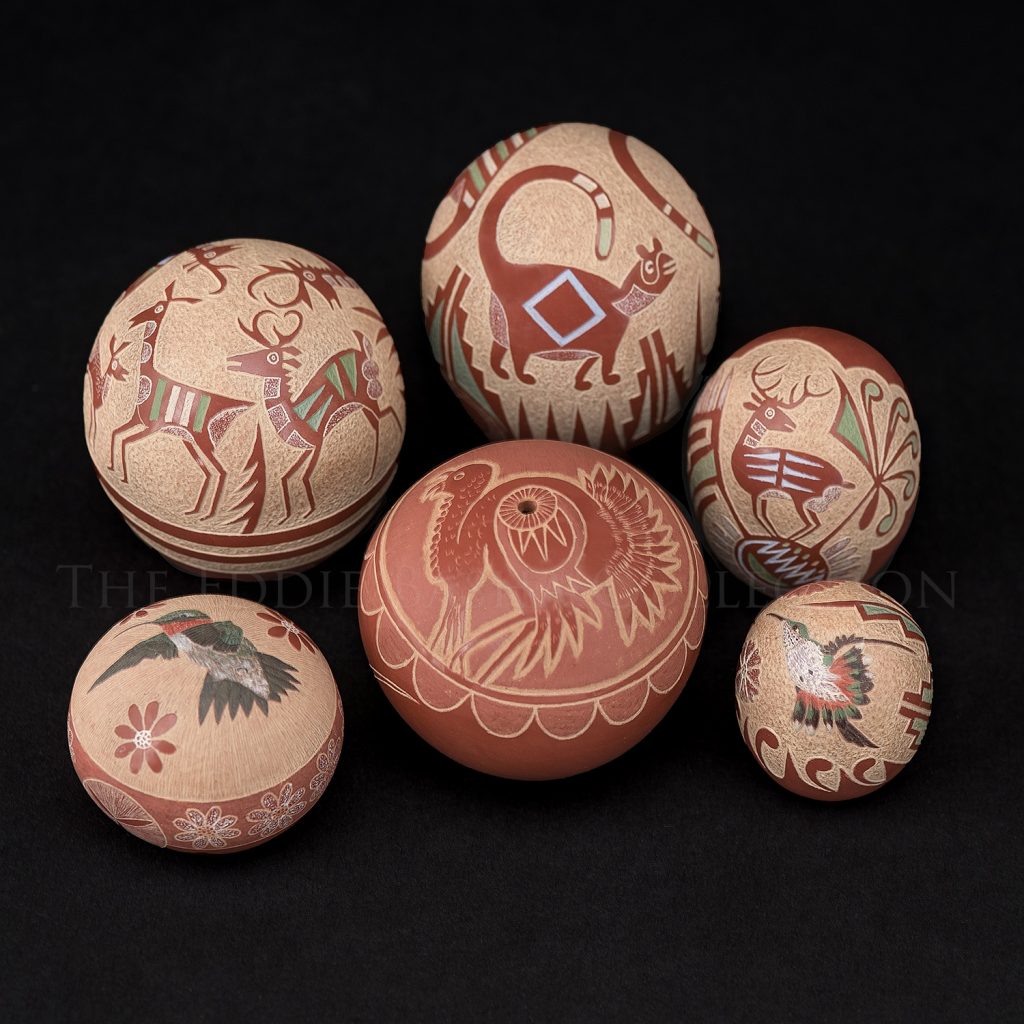 Seed Pots | Assorted Sizes Ranging from ¾”h to 1 ½”d
Seed Pots | Assorted Sizes Ranging from ¾”h to 1 ½”dJoseph Lonewolf (1932-2014) was the son of noted potters Camilio and Agapita Tafoya and the brother of Grace Medicine Flower. Beginning in the early 1970's, Lonewolf revolutionized the world of Santa Clara pottery by incorporating his sgraffito (lightly etching the surface of the clay) and incised (more deeply cut into the clay) designs in his work. He won numerous awards throughout his career and his work can be found in museums worldwide. He was also featured in numerous books including "The Art of Clay" and received the prestigious New Mexico Governor's Award for Excellence in the Arts and the SWAIA Lifetime Achievement Award.
Unknown Titles | Joseph Lonewolf (1932-2014)
Artist: American Indian Potter
Description:
Seed Pots | Assorted Sizes Ranging from ¾”h to 1 ½”d
Joseph Lonewolf (1932-2014) was the son of noted potters Camilio and Agapita Tafoya and the brother of Grace Medicine Flower. Beginning in the early 1970's, Lonewolf revolutionized the world of Santa Clara pottery by incorporating his sgraffito (lightly etching the surface of the clay) and incised (more deeply cut into the clay) designs in his work. He won numerous awards throughout his career and his work can be found in museums worldwide. He was also featured in numerous books including "The Art of Clay" and received the prestigious New Mexico Governor's Award for Excellence in the Arts and the SWAIA Lifetime Achievement Award.
potteryJoseph Lonewolf (1932-2014) was the son of noted potters Camilio and Agapita Tafoya and the brother of Grace Medicine Flower. Beginning in the early 1970's, Lonewolf revolutionized the world of Santa Clara pottery by incorporating his sgraffito (lightly etching the surface of the clay) and incised (more deeply cut into the clay) designs in his work. He won numerous awards throughout his career and his work can be found in museums worldwide. He was also featured in numerous books including "The Art of Clay" and received the prestigious New Mexico Governor's Award for Excellence in the Arts and the SWAIA Lifetime Achievement Award.
 Clay | Dimensions: 5”h x 5”d
Clay | Dimensions: 5”h x 5”d The deeply incised kiva step pattern of Anita Suazo’s black on black jar encircles the circumference of the piece. Culturally, the steps symbolize man’s journey from the three levels of the underworld to the upper world.
Suazo’s pedigree is impeccable. Anita’s mother, Belen “Tafoya” Tapia, was an innovator of polychrome redware pottery and began sharing her techniques with her daughter when she was just a child. Suazo has used that knowledge in her own practice and has shared it with others through various workshops and demonstrations. Her work is sought after by museums and collectors alike.
Kiva Step Jar | Anita Suazo (b.1937)
Artist: American Indian Potter
Description:
Clay | Dimensions: 5”h x 5”d
The deeply incised kiva step pattern of Anita Suazo’s black on black jar encircles the circumference of the piece. Culturally, the steps symbolize man’s journey from the three levels of the underworld to the upper world.
Suazo’s pedigree is impeccable. Anita’s mother, Belen “Tafoya” Tapia, was an innovator of polychrome redware pottery and began sharing her techniques with her daughter when she was just a child. Suazo has used that knowledge in her own practice and has shared it with others through various workshops and demonstrations. Her work is sought after by museums and collectors alike.
potteryThe deeply incised kiva step pattern of Anita Suazo’s black on black jar encircles the circumference of the piece. Culturally, the steps symbolize man’s journey from the three levels of the underworld to the upper world.
Suazo’s pedigree is impeccable. Anita’s mother, Belen “Tafoya” Tapia, was an innovator of polychrome redware pottery and began sharing her techniques with her daughter when she was just a child. Suazo has used that knowledge in her own practice and has shared it with others through various workshops and demonstrations. Her work is sought after by museums and collectors alike.
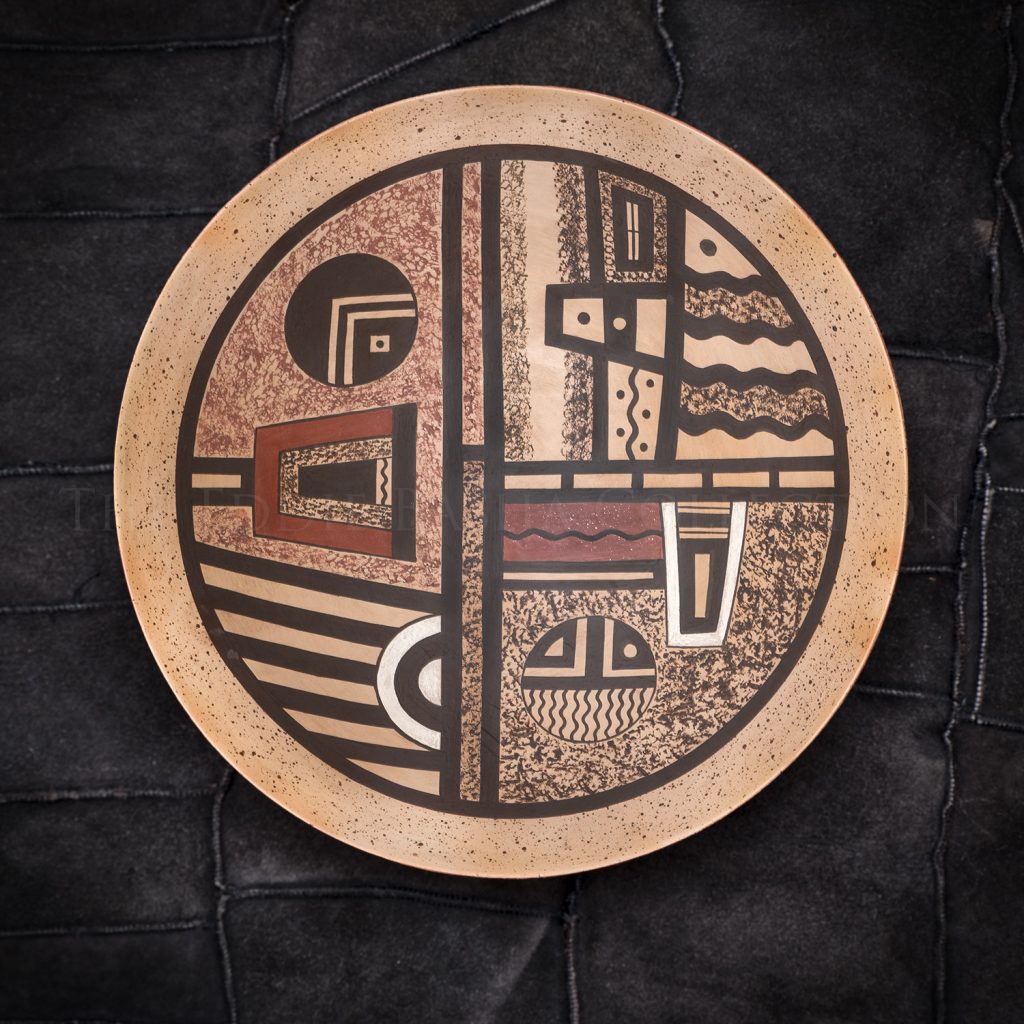 Pottery | Dimensions: 10 ½” diameter x 2 ½” deep
Pottery | Dimensions: 10 ½” diameter x 2 ½” deepHopi potter, Steve Lucas, is the great-great grandson of Nampeyo of Hano. While Lucas grew up around pottery, he largely learned the art from his aunt, Dextra Quotskuyva Nampeyo. Lucas’ pottery is known for its extremely thin walls. The pottery is coil built, stone polished, painted, and traditionally fired. Lucas incorporates traditional designs in his work but often adds his own style or flourish. His pottery is signed with his name and the Mudhead symbol, or Koyemsi. The signature is reflective of his Hopi-Tewa Clan. Lucas has won a number of awards for his work including Best of Show at Santa Fe Indian Market.
Polychrome Bowl | Steve Lucas (b.1955)
Artist: American Indian Potter
Description:
Pottery | Dimensions: 10 ½” diameter x 2 ½” deep
Hopi potter, Steve Lucas, is the great-great grandson of Nampeyo of Hano. While Lucas grew up around pottery, he largely learned the art from his aunt, Dextra Quotskuyva Nampeyo. Lucas’ pottery is known for its extremely thin walls. The pottery is coil built, stone polished, painted, and traditionally fired. Lucas incorporates traditional designs in his work but often adds his own style or flourish. His pottery is signed with his name and the Mudhead symbol, or Koyemsi. The signature is reflective of his Hopi-Tewa Clan. Lucas has won a number of awards for his work including Best of Show at Santa Fe Indian Market.
potteryHopi potter, Steve Lucas, is the great-great grandson of Nampeyo of Hano. While Lucas grew up around pottery, he largely learned the art from his aunt, Dextra Quotskuyva Nampeyo. Lucas’ pottery is known for its extremely thin walls. The pottery is coil built, stone polished, painted, and traditionally fired. Lucas incorporates traditional designs in his work but often adds his own style or flourish. His pottery is signed with his name and the Mudhead symbol, or Koyemsi. The signature is reflective of his Hopi-Tewa Clan. Lucas has won a number of awards for his work including Best of Show at Santa Fe Indian Market.
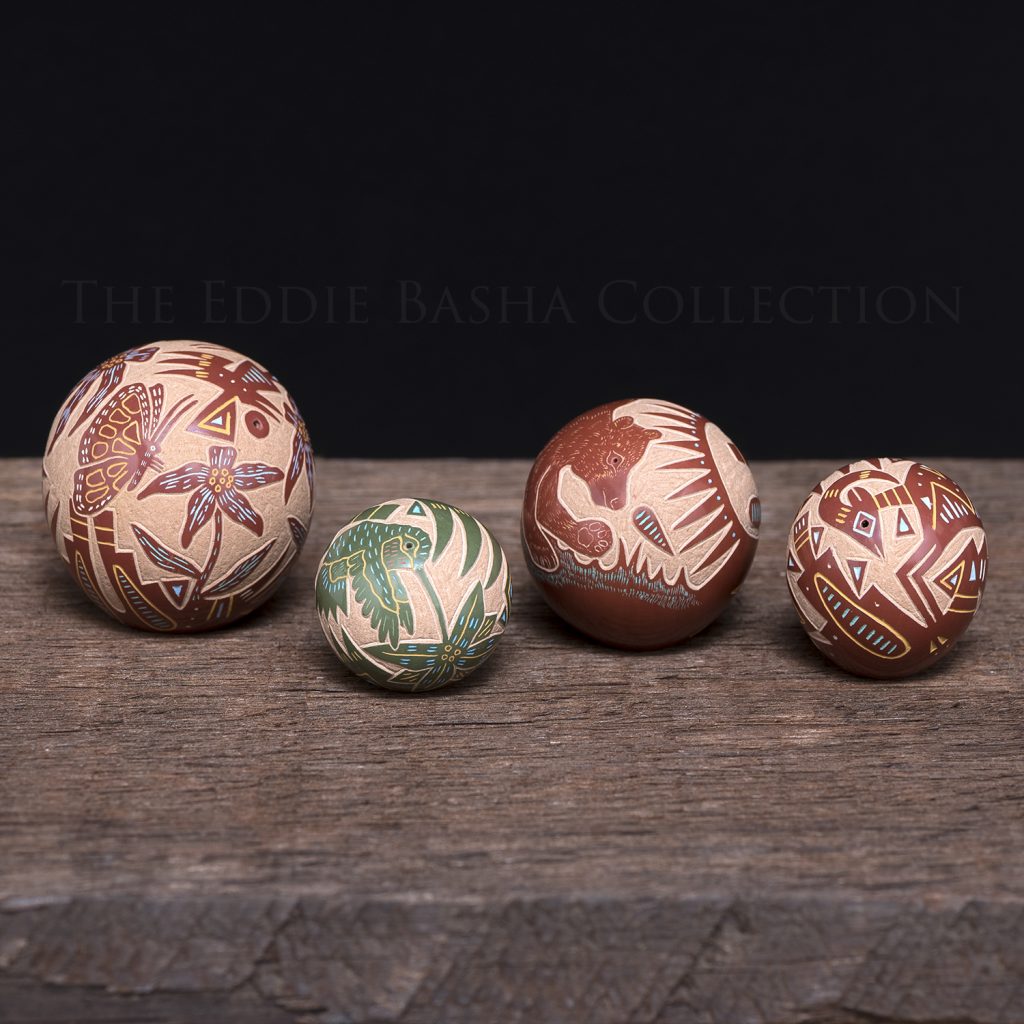 Dimensions:
Dimensions:Left: 2”h x 2”d
2nd from Left: 1”h x 1 ¼”d
3rd from Left: 1 ½”h x 1 ½”d
4TH from Left: 1 ¼”h x 1 ¼”d
Ray Tafoya of the famed Tafoya family of Santa Clara Pueblo potters specialized in miniature seed pots and jars and was an innovator with his use of Mimbres-like designs, patterns and larger plain surfaces with highlighted designs in a variety of clay color slips in beautiful pastel shades of yellow, blue, green and white. On such small surfaces, some only 1” in height and diameter, it is amazing to behold the exacting features of hummingbirds, rams, bears, butterflies, flowers, corn and the sun so expertly depicted.
Tafoya’s work can be found in museums, private collections (the EBC comes to mind), and galleries specializing in American Indian Fine Art Masterworks.
Clay Seed Pots | Ray Tafoya (1956-1994)
Artist: American Indian Potter
Description:
Dimensions:
Left: 2”h x 2”d
2nd from Left: 1”h x 1 ¼”d
3rd from Left: 1 ½”h x 1 ½”d
4TH from Left: 1 ¼”h x 1 ¼”d
Ray Tafoya of the famed Tafoya family of Santa Clara Pueblo potters specialized in miniature seed pots and jars and was an innovator with his use of Mimbres-like designs, patterns and larger plain surfaces with highlighted designs in a variety of clay color slips in beautiful pastel shades of yellow, blue, green and white. On such small surfaces, some only 1” in height and diameter, it is amazing to behold the exacting features of hummingbirds, rams, bears, butterflies, flowers, corn and the sun so expertly depicted.
Tafoya’s work can be found in museums, private collections (the EBC comes to mind), and galleries specializing in American Indian Fine Art Masterworks.
potteryLeft: 2”h x 2”d
2nd from Left: 1”h x 1 ¼”d
3rd from Left: 1 ½”h x 1 ½”d
4TH from Left: 1 ¼”h x 1 ¼”d
Ray Tafoya of the famed Tafoya family of Santa Clara Pueblo potters specialized in miniature seed pots and jars and was an innovator with his use of Mimbres-like designs, patterns and larger plain surfaces with highlighted designs in a variety of clay color slips in beautiful pastel shades of yellow, blue, green and white. On such small surfaces, some only 1” in height and diameter, it is amazing to behold the exacting features of hummingbirds, rams, bears, butterflies, flowers, corn and the sun so expertly depicted.
Tafoya’s work can be found in museums, private collections (the EBC comes to mind), and galleries specializing in American Indian Fine Art Masterworks.
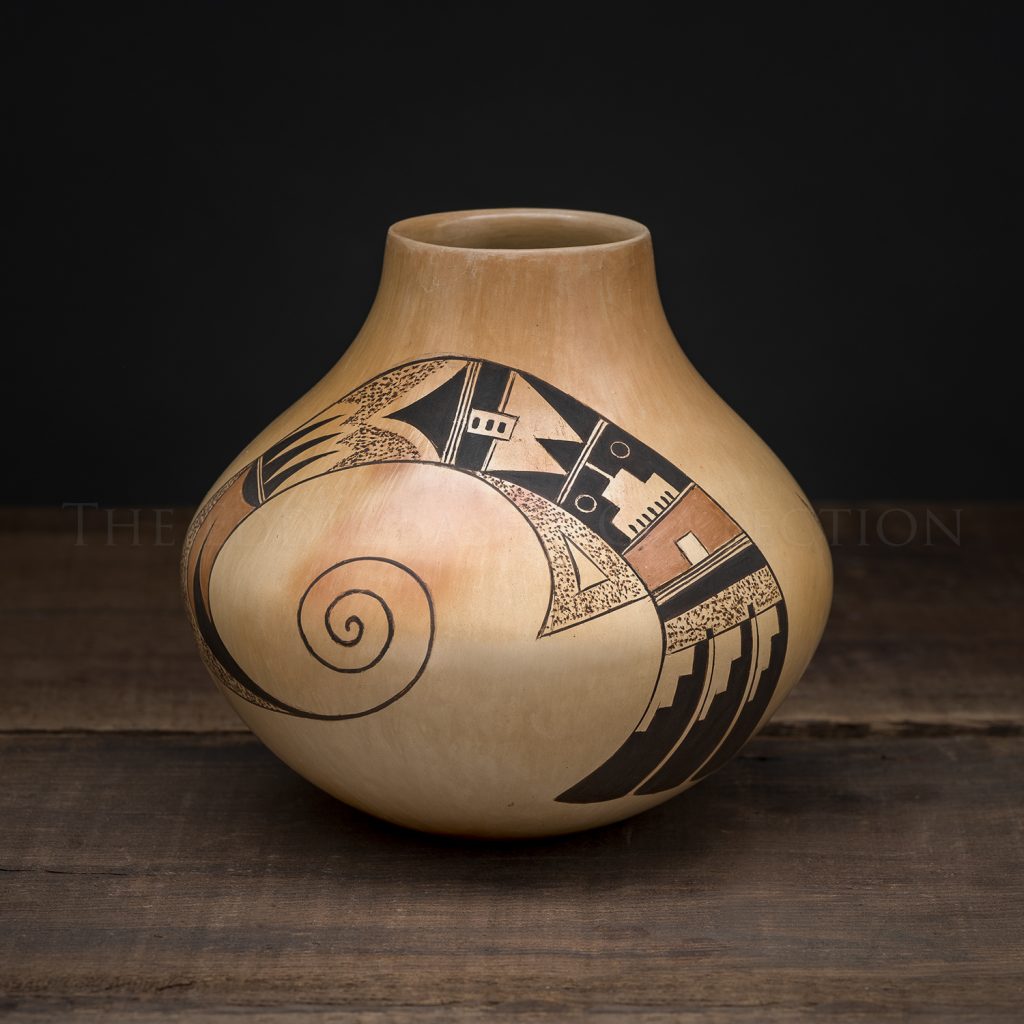 Clay | Dimensions: 6”h x 6”d
Clay | Dimensions: 6”h x 6”dHopi artist, Dextra Nampeyo, the great granddaughter of famed potter, Nampeyo of Hano who is credited with reviving the ancient Sikyatki form of pottery, began her career utilizing many of the traditional designs favored by her mother, grandmother, and great grandmother, but in later years incorporated many of her own innovative design concepts into her work. Dextra’s pottery is known for the graceful quality of its design, its near flawless surfaces, and its detailed and striking design elements. She utilized only traditional Hopi pottery methods in hand coil construction, stone polish, paint, and open fire. Dextra passed on her techniques to a younger generation of artists and has been an inspiration to other Hopi artists, such as her son, the painter and sculptor, Dan Namingha.
In 1994, Dextra was proclaimed an “Arizona Living Treasure,” and in 1998 she received the first Arizona State Museum Lifetime Achievement Award. Her work can be found in many museums such as the Smithsonian National Museum of the American Indian, private collections and has been the subject of retrospective exhibitions at the Museum of Northern Arizona and another with a full color exhibition catalog entitled “Painted Perfection” at the Wheelwright Museum in Santa Fe.
Polychrome Pot with Swirling Pueblo Motifs | Dextra Nampeyo (1928-2019)
Artist: American Indian Potter
Description:
Clay | Dimensions: 6”h x 6”d
Hopi artist, Dextra Nampeyo, the great granddaughter of famed potter, Nampeyo of Hano who is credited with reviving the ancient Sikyatki form of pottery, began her career utilizing many of the traditional designs favored by her mother, grandmother, and great grandmother, but in later years incorporated many of her own innovative design concepts into her work. Dextra’s pottery is known for the graceful quality of its design, its near flawless surfaces, and its detailed and striking design elements. She utilized only traditional Hopi pottery methods in hand coil construction, stone polish, paint, and open fire. Dextra passed on her techniques to a younger generation of artists and has been an inspiration to other Hopi artists, such as her son, the painter and sculptor, Dan Namingha.
In 1994, Dextra was proclaimed an “Arizona Living Treasure,” and in 1998 she received the first Arizona State Museum Lifetime Achievement Award. Her work can be found in many museums such as the Smithsonian National Museum of the American Indian, private collections and has been the subject of retrospective exhibitions at the Museum of Northern Arizona and another with a full color exhibition catalog entitled “Painted Perfection” at the Wheelwright Museum in Santa Fe.
potteryHopi artist, Dextra Nampeyo, the great granddaughter of famed potter, Nampeyo of Hano who is credited with reviving the ancient Sikyatki form of pottery, began her career utilizing many of the traditional designs favored by her mother, grandmother, and great grandmother, but in later years incorporated many of her own innovative design concepts into her work. Dextra’s pottery is known for the graceful quality of its design, its near flawless surfaces, and its detailed and striking design elements. She utilized only traditional Hopi pottery methods in hand coil construction, stone polish, paint, and open fire. Dextra passed on her techniques to a younger generation of artists and has been an inspiration to other Hopi artists, such as her son, the painter and sculptor, Dan Namingha.
In 1994, Dextra was proclaimed an “Arizona Living Treasure,” and in 1998 she received the first Arizona State Museum Lifetime Achievement Award. Her work can be found in many museums such as the Smithsonian National Museum of the American Indian, private collections and has been the subject of retrospective exhibitions at the Museum of Northern Arizona and another with a full color exhibition catalog entitled “Painted Perfection” at the Wheelwright Museum in Santa Fe.
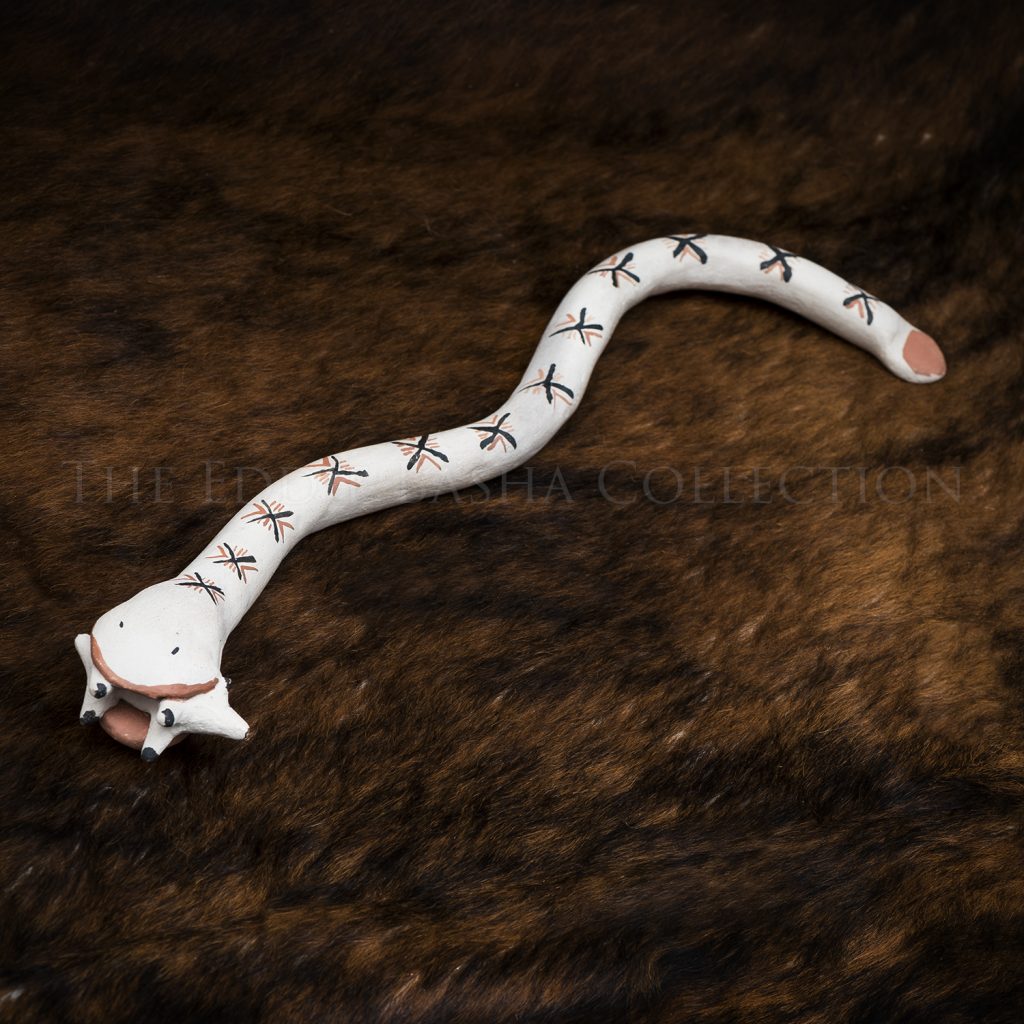 Pottery | Dimensions: 1”h x 4”w x 16”
Pottery | Dimensions: 1”h x 4”w x 16”Josephine Arquero, a Cochiti Pueblo Potter, learned the construction aspects of her craft from her mother, Damacia Cordero. Josephine specialized in figurative pottery such as storytellers, nativity scenes and animals such as the serpent shown here.
Serpent | Josephine Arquero (1928-2019)
Artist: American Indian Potter
Description:
Pottery | Dimensions: 1”h x 4”w x 16”
Josephine Arquero, a Cochiti Pueblo Potter, learned the construction aspects of her craft from her mother, Damacia Cordero. Josephine specialized in figurative pottery such as storytellers, nativity scenes and animals such as the serpent shown here.
potteryJosephine Arquero, a Cochiti Pueblo Potter, learned the construction aspects of her craft from her mother, Damacia Cordero. Josephine specialized in figurative pottery such as storytellers, nativity scenes and animals such as the serpent shown here.
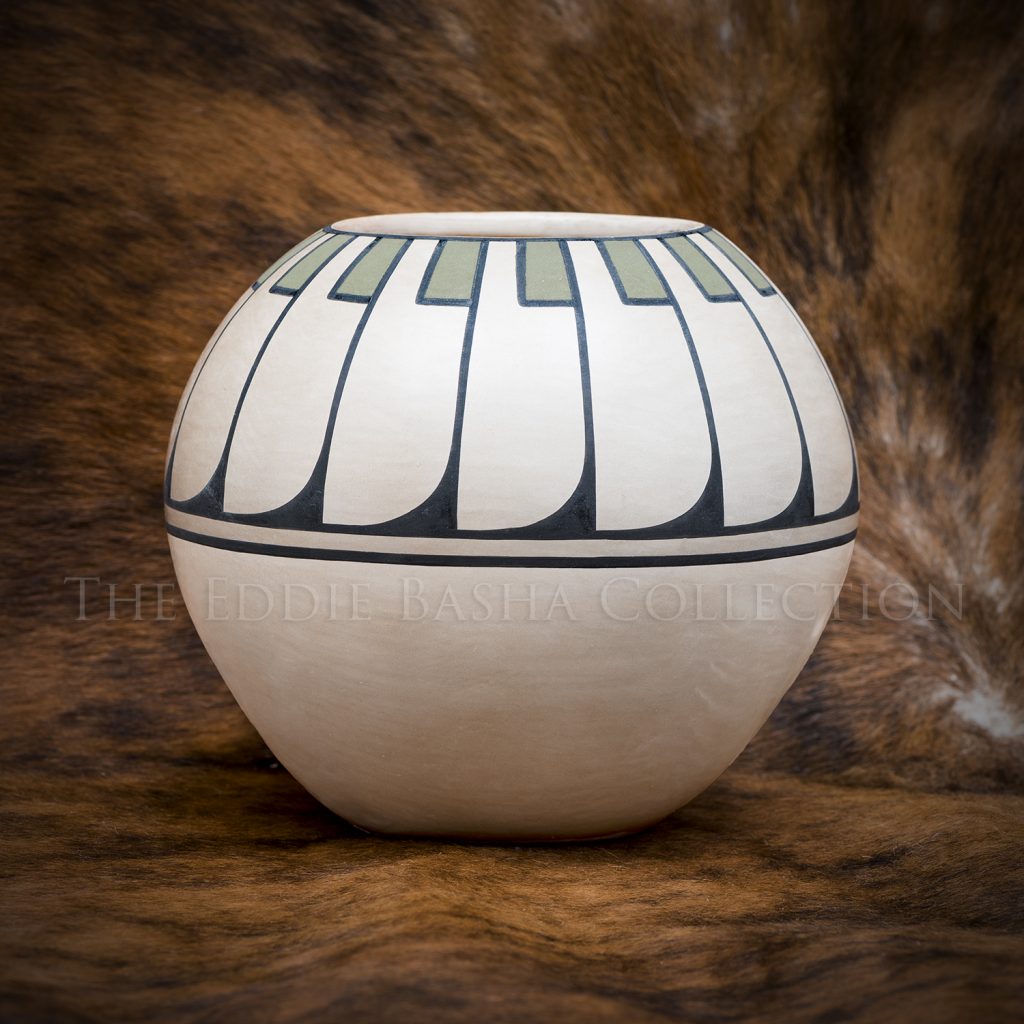 Pottery
Pottery Blue Corn was born Crucita Calabaza at San Ildefonso Pueblo. She learned to make pottery from her mother. While attending the Santa Fe Indian School her parents passed away and she was sent to live with relatives in Southern California. Her husband, Santiago “Sandy” Calabaza was a silversmith from the Santa Domingo Pueblo. Together they settled in San Ildefonso.
Blue Corn was renowned for her polychrome pottery as well as her distinctive blackware. She became famous for reviving San Ildefonso polychrome wares and had a very long and productive career. In 1981, she received the New Mexico Governor’s Award for Excellence in the Arts and in 2008 she was posthumously given the Lifetime Achievement Award by Southwestern Association for Indian Arts - Santa Fe Indian Market.
Melon Pot | Blue Corn (Crucita Calabaza) (1922-1999)
Artist: American Indian Potter
Description:
Pottery
Blue Corn was born Crucita Calabaza at San Ildefonso Pueblo. She learned to make pottery from her mother. While attending the Santa Fe Indian School her parents passed away and she was sent to live with relatives in Southern California. Her husband, Santiago “Sandy” Calabaza was a silversmith from the Santa Domingo Pueblo. Together they settled in San Ildefonso.
Blue Corn was renowned for her polychrome pottery as well as her distinctive blackware. She became famous for reviving San Ildefonso polychrome wares and had a very long and productive career. In 1981, she received the New Mexico Governor’s Award for Excellence in the Arts and in 2008 she was posthumously given the Lifetime Achievement Award by Southwestern Association for Indian Arts - Santa Fe Indian Market.
potteryBlue Corn was born Crucita Calabaza at San Ildefonso Pueblo. She learned to make pottery from her mother. While attending the Santa Fe Indian School her parents passed away and she was sent to live with relatives in Southern California. Her husband, Santiago “Sandy” Calabaza was a silversmith from the Santa Domingo Pueblo. Together they settled in San Ildefonso.
Blue Corn was renowned for her polychrome pottery as well as her distinctive blackware. She became famous for reviving San Ildefonso polychrome wares and had a very long and productive career. In 1981, she received the New Mexico Governor’s Award for Excellence in the Arts and in 2008 she was posthumously given the Lifetime Achievement Award by Southwestern Association for Indian Arts - Santa Fe Indian Market.
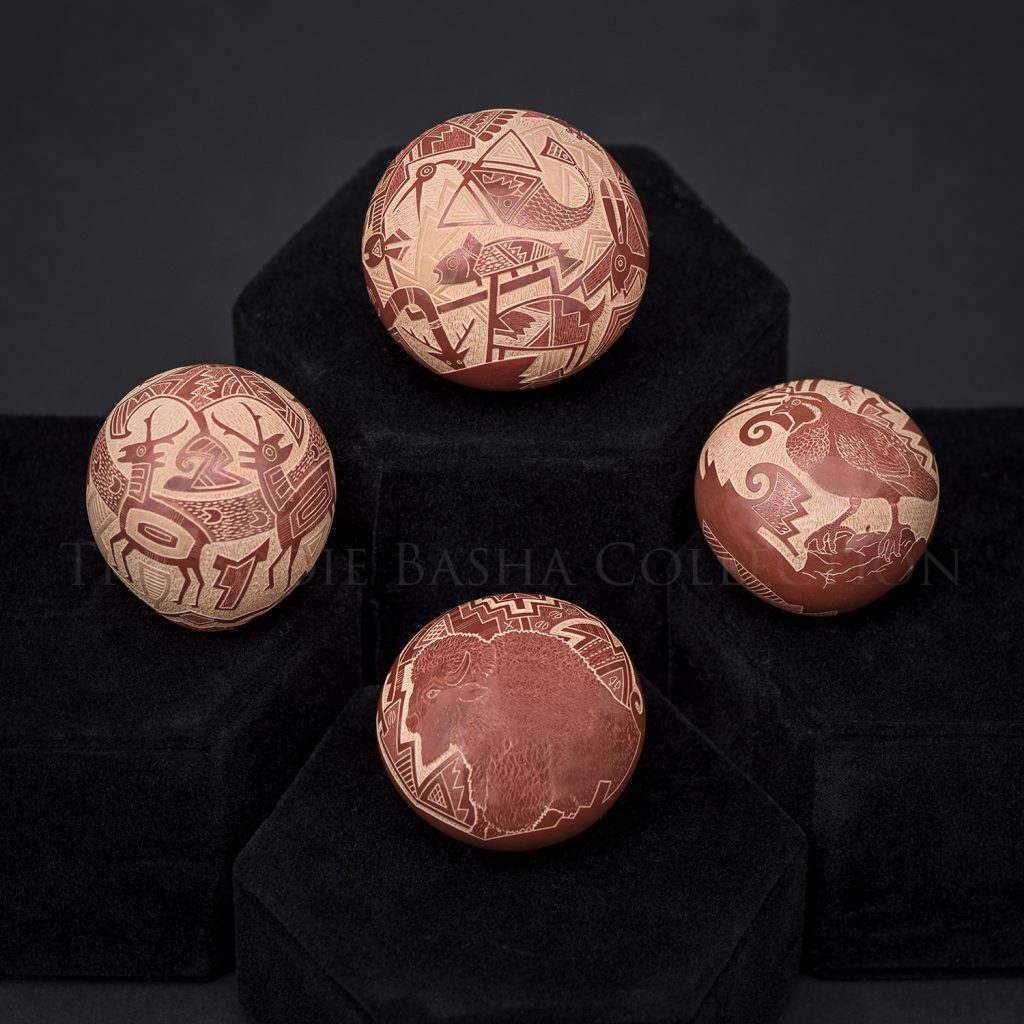 Clay | Left (Antelope): 2”h x 1 3/4”d; Top (Zoomorphic Figures): 2”h x 2”d; Right (Quail): 1 ½”h x 1 ½”d; Bottom (Bison): 1 ½”h x 2”d
Clay | Left (Antelope): 2”h x 1 3/4”d; Top (Zoomorphic Figures): 2”h x 2”d; Right (Quail): 1 ½”h x 1 ½”d; Bottom (Bison): 1 ½”h x 2”dActively creating pots since the 1970’s, Santa Clara potter Susan Romero learned how to etch her pottery from her father Joseph Lonewolf. She signs her pieces with her Tewa name, "Pho-Sa-We" or "Snowflake”. Her pottery is highly polished and intricately etched with detailed imagery. Her technique of scratching the design into the surface of the clay allows her to create numerous levels by contrasting the color of the clay. The polished, red and tan matte coloration became her palate for the designs.
Sgraffito Seed Pots | Sue Romero; Tewa Name: “Pho-Sa-We” or “Snowflake” (b.1955)
Artist: American Indian Potter
Description:
Clay | Left (Antelope): 2”h x 1 3/4”d; Top (Zoomorphic Figures): 2”h x 2”d; Right (Quail): 1 ½”h x 1 ½”d; Bottom (Bison): 1 ½”h x 2”d
Actively creating pots since the 1970’s, Santa Clara potter Susan Romero learned how to etch her pottery from her father Joseph Lonewolf. She signs her pieces with her Tewa name, "Pho-Sa-We" or "Snowflake”. Her pottery is highly polished and intricately etched with detailed imagery. Her technique of scratching the design into the surface of the clay allows her to create numerous levels by contrasting the color of the clay. The polished, red and tan matte coloration became her palate for the designs.
potteryActively creating pots since the 1970’s, Santa Clara potter Susan Romero learned how to etch her pottery from her father Joseph Lonewolf. She signs her pieces with her Tewa name, "Pho-Sa-We" or "Snowflake”. Her pottery is highly polished and intricately etched with detailed imagery. Her technique of scratching the design into the surface of the clay allows her to create numerous levels by contrasting the color of the clay. The polished, red and tan matte coloration became her palate for the designs.
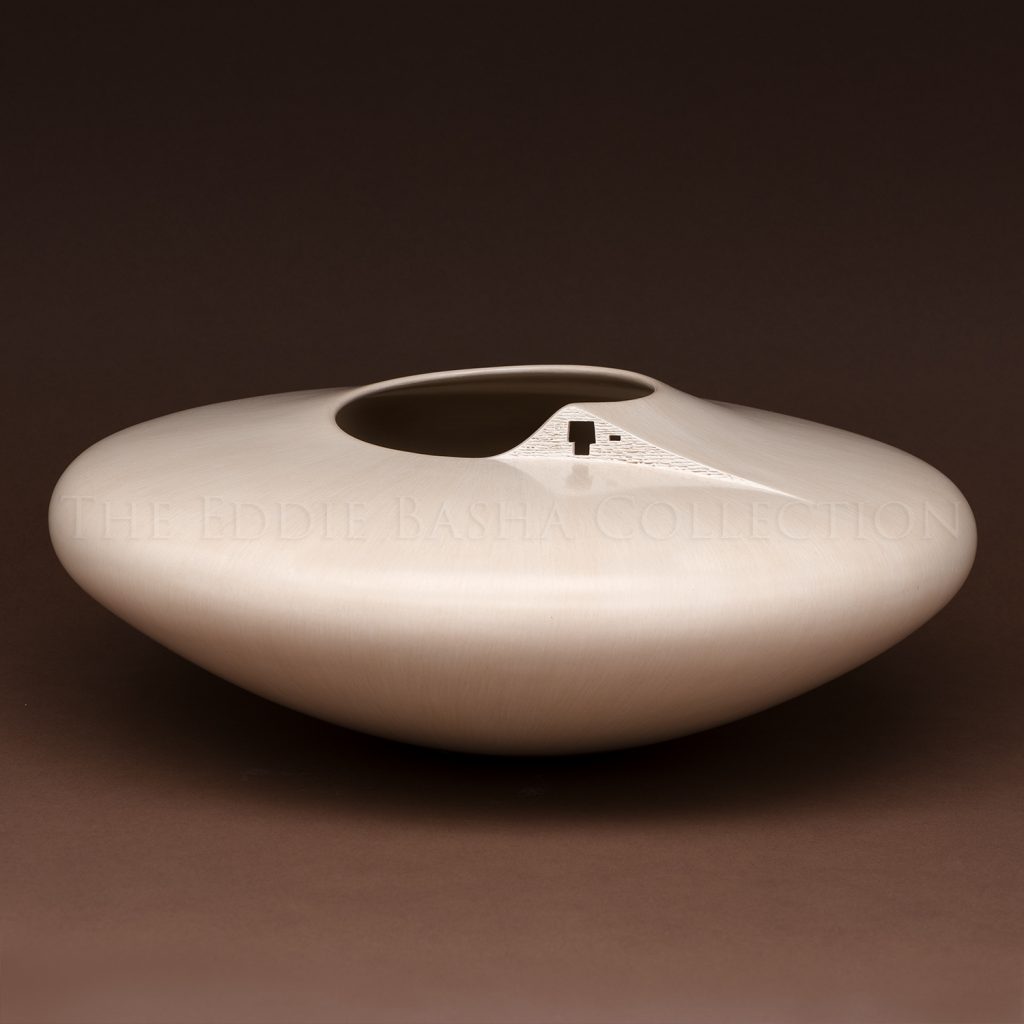 Pottery | Dimensions: 7”h x 18”w
Pottery | Dimensions: 7”h x 18”wSpending a professional career in the aerospace industry, Al Qöyawayma is equally at ease in the worlds of science and art. His pottery is reflective of his Hopi culture with traditional designs and symbols embedded therein such as the organic rim of this piece highlighting a cliff dwelling. Its classically simple yet elegant lines are enhanced by the subtle hue reminiscent of a high desert landscape. And if you listen closely, you can hear the gentle whispers in the wind of those who once resided there.
Unknown Title | Al Qöyawayma (b.1938)
Artist: American Indian Potter
Description:
Pottery | Dimensions: 7”h x 18”w
Spending a professional career in the aerospace industry, Al Qöyawayma is equally at ease in the worlds of science and art. His pottery is reflective of his Hopi culture with traditional designs and symbols embedded therein such as the organic rim of this piece highlighting a cliff dwelling. Its classically simple yet elegant lines are enhanced by the subtle hue reminiscent of a high desert landscape. And if you listen closely, you can hear the gentle whispers in the wind of those who once resided there.
potterySpending a professional career in the aerospace industry, Al Qöyawayma is equally at ease in the worlds of science and art. His pottery is reflective of his Hopi culture with traditional designs and symbols embedded therein such as the organic rim of this piece highlighting a cliff dwelling. Its classically simple yet elegant lines are enhanced by the subtle hue reminiscent of a high desert landscape. And if you listen closely, you can hear the gentle whispers in the wind of those who once resided there.
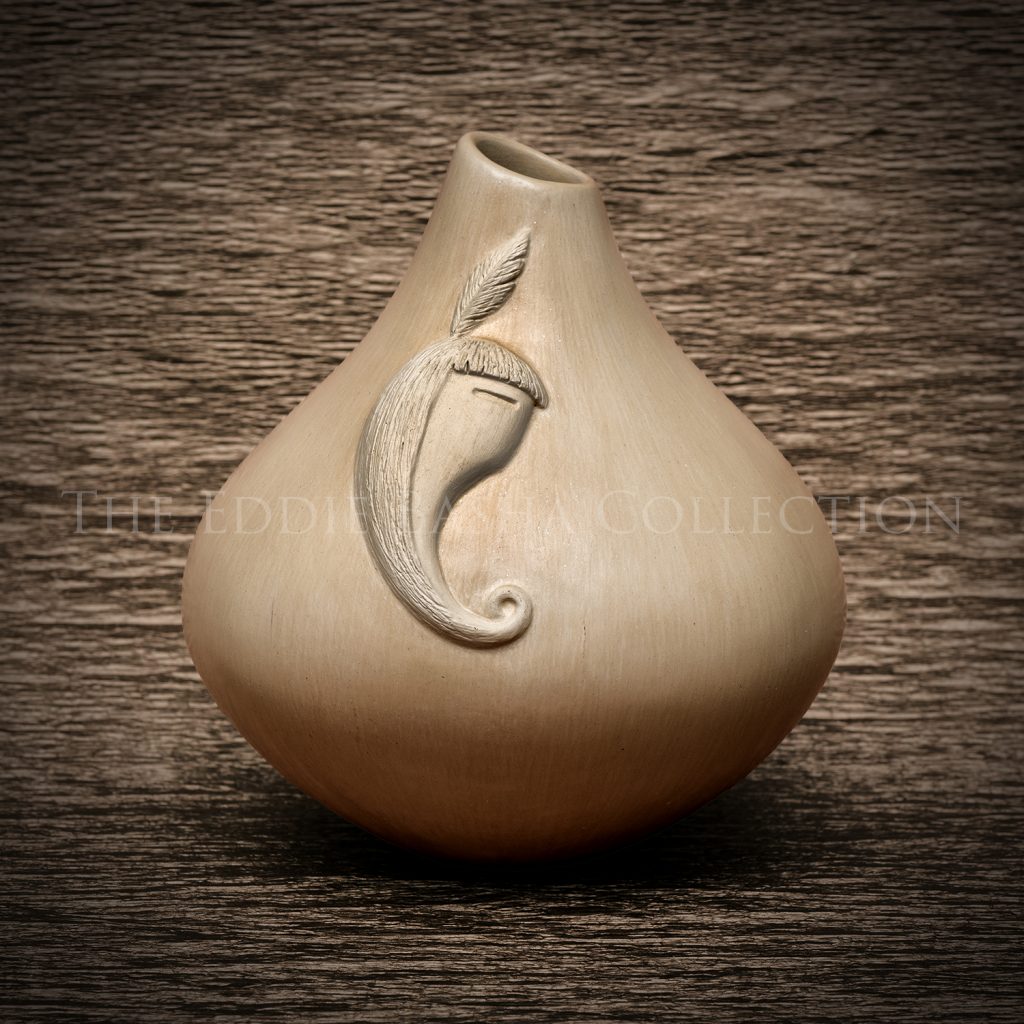 Clay | Dimensions: 6”h x 6”d
Clay | Dimensions: 6”h x 6”dAl Qöyawayma’s work which has been described as “minimalist", reflects simple lines, the hues and shadows of high desert landscapes, and the softness of human touch while incorporating values of his Hopi culture.
Equally at ease in the worlds of science or art, Qöyawyma’s pottery utilizes traditional designs and symbols, but his work also has a distinctively modernistic look and feel. His pots appeal to collectors of American Indian art as well as modern sculpture.
Hopi Relief Jar | Al Qöyawayma (b.1938)
Artist: American Indian Potter
Description:
Clay | Dimensions: 6”h x 6”d
Al Qöyawayma’s work which has been described as “minimalist", reflects simple lines, the hues and shadows of high desert landscapes, and the softness of human touch while incorporating values of his Hopi culture.
Equally at ease in the worlds of science or art, Qöyawyma’s pottery utilizes traditional designs and symbols, but his work also has a distinctively modernistic look and feel. His pots appeal to collectors of American Indian art as well as modern sculpture.
potteryAl Qöyawayma’s work which has been described as “minimalist", reflects simple lines, the hues and shadows of high desert landscapes, and the softness of human touch while incorporating values of his Hopi culture.
Equally at ease in the worlds of science or art, Qöyawyma’s pottery utilizes traditional designs and symbols, but his work also has a distinctively modernistic look and feel. His pots appeal to collectors of American Indian art as well as modern sculpture.
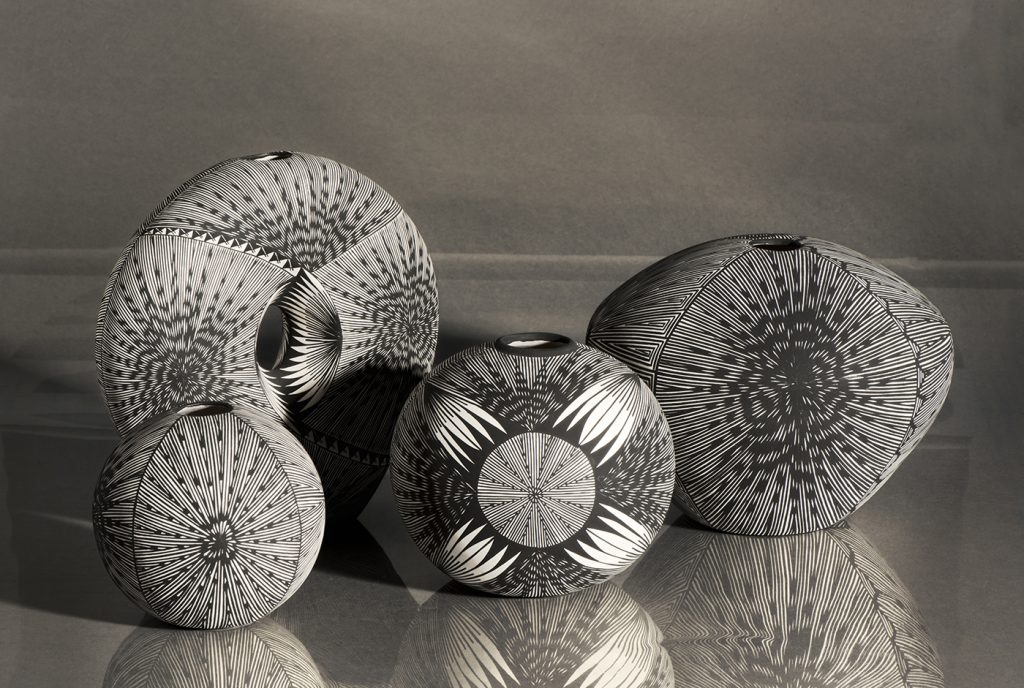 Dorothy, Jennifer & Selena Sanchez | Assorted Sizes: Tallest 7"
Dorothy, Jennifer & Selena Sanchez | Assorted Sizes: Tallest 7"Acoma pottery is a traditional Pueblo technique known for is intricate geometric design. Pottery by Dorothy, Jennifer & Selena Sanchez.
Acoma Pottery | Sanchez Family
Artist: American Indian Potter
Description:
Dorothy, Jennifer & Selena Sanchez | Assorted Sizes: Tallest 7"
Acoma pottery is a traditional Pueblo technique known for is intricate geometric design. Pottery by Dorothy, Jennifer & Selena Sanchez.
potteryAcoma pottery is a traditional Pueblo technique known for is intricate geometric design. Pottery by Dorothy, Jennifer & Selena Sanchez.
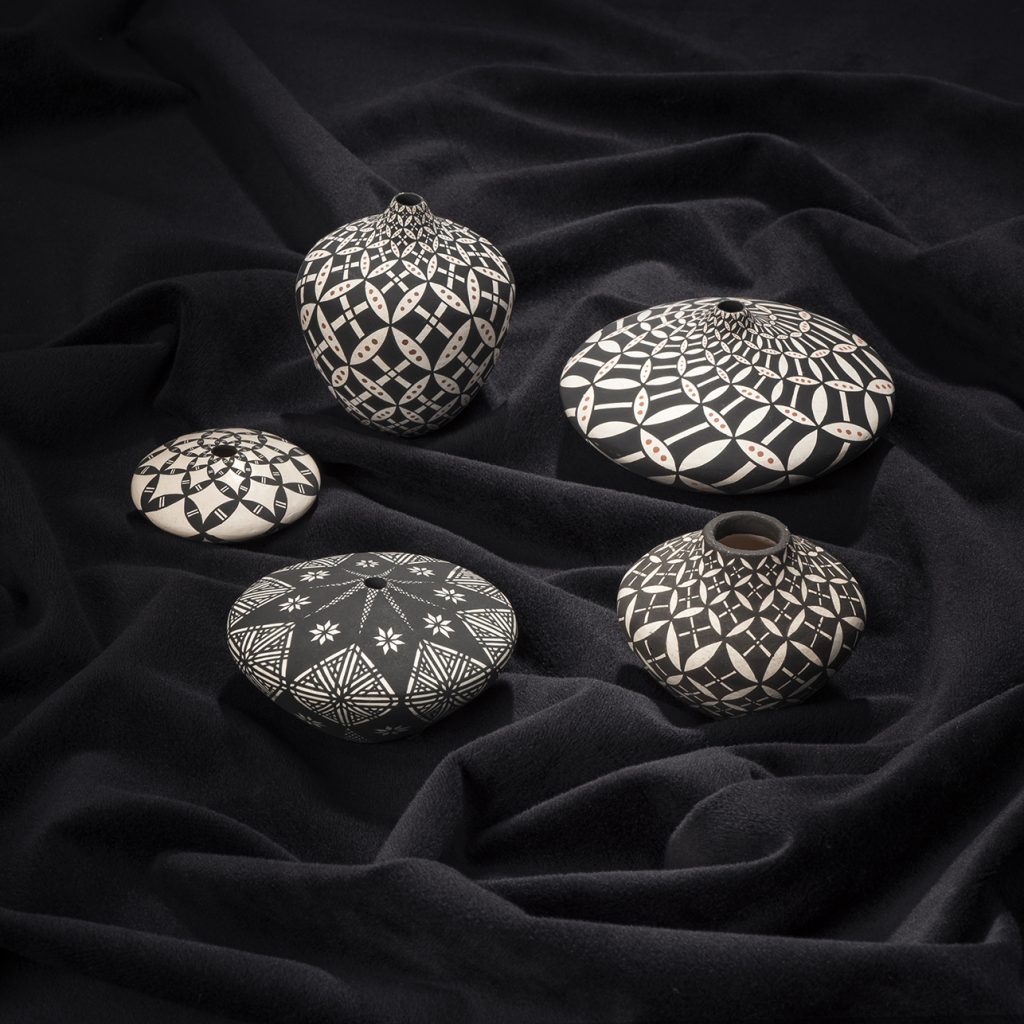 Clay | Tallest Height 3”; Largest Diameter 4”
Clay | Tallest Height 3”; Largest Diameter 4”Dorothy Torivio, Acoma Pueblo, was among the first to utilize and then refine the "op-art" style in her pottery. She took classic Acoma patterns and then repeated them on a vessel, ranging the size from small to large and then small again, in accordance with the shape of the vessel. Dorothy has won numerous awards for her pottery, including Best of Pottery at the Heard Museum Guild Indian Fair & Market and was featured in books such as "The Art of Clay" and "Legacy of Generations." Utilizing repurposed yucca stalks as a brush, Dorothy paints the black on white pottery backgrounds which reverses the look of the pot.
Acoma Pottery | Dorothy Torivio (b.1946)
Artist: American Indian Potter
Description:
Clay | Tallest Height 3”; Largest Diameter 4”
Dorothy Torivio, Acoma Pueblo, was among the first to utilize and then refine the "op-art" style in her pottery. She took classic Acoma patterns and then repeated them on a vessel, ranging the size from small to large and then small again, in accordance with the shape of the vessel. Dorothy has won numerous awards for her pottery, including Best of Pottery at the Heard Museum Guild Indian Fair & Market and was featured in books such as "The Art of Clay" and "Legacy of Generations." Utilizing repurposed yucca stalks as a brush, Dorothy paints the black on white pottery backgrounds which reverses the look of the pot.
potteryDorothy Torivio, Acoma Pueblo, was among the first to utilize and then refine the "op-art" style in her pottery. She took classic Acoma patterns and then repeated them on a vessel, ranging the size from small to large and then small again, in accordance with the shape of the vessel. Dorothy has won numerous awards for her pottery, including Best of Pottery at the Heard Museum Guild Indian Fair & Market and was featured in books such as "The Art of Clay" and "Legacy of Generations." Utilizing repurposed yucca stalks as a brush, Dorothy paints the black on white pottery backgrounds which reverses the look of the pot.
 Clay | Dimensions: 6”h x 12”w
Clay | Dimensions: 6”h x 12”wThough Alton Komalestewa is a descendant of famed Hopi potter Nampeyo of Hano, Komalestewa learned to make pottery from his mother-in-law, Helen Shupla, of the Santa Clara Pueblo. She taught him the process of making her signature melon bowls and jars in which designs are pushed out from the inside of the pot, not carved from the outside. Often they are referred to as undulating ribs. Following the deaths of his wife and mother-in-law, both in 1989, Komalestewa returned to the Hopi where he continued to produce pottery in the Helen Shupla style, only with Hopi clay. In 2001, he returned to the Santa Clara Pueblo area and once again began using local pueblo clays and slips.
While this pot is smooth and doesn’t have the ribs often associated with his work, its meticulous shape and highly polished surface is indicative of the style Alton Komalestewa learned from his mother-in-law. Komalestewa’s pots are the only heirs to the Shupla style of melon pots.
Sienna Melon Pot | Alton Komalestewa (b.1959)
Artist: American Indian Potter
Description:
Clay | Dimensions: 6”h x 12”w
Though Alton Komalestewa is a descendant of famed Hopi potter Nampeyo of Hano, Komalestewa learned to make pottery from his mother-in-law, Helen Shupla, of the Santa Clara Pueblo. She taught him the process of making her signature melon bowls and jars in which designs are pushed out from the inside of the pot, not carved from the outside. Often they are referred to as undulating ribs. Following the deaths of his wife and mother-in-law, both in 1989, Komalestewa returned to the Hopi where he continued to produce pottery in the Helen Shupla style, only with Hopi clay. In 2001, he returned to the Santa Clara Pueblo area and once again began using local pueblo clays and slips.
While this pot is smooth and doesn’t have the ribs often associated with his work, its meticulous shape and highly polished surface is indicative of the style Alton Komalestewa learned from his mother-in-law. Komalestewa’s pots are the only heirs to the Shupla style of melon pots.
potteryThough Alton Komalestewa is a descendant of famed Hopi potter Nampeyo of Hano, Komalestewa learned to make pottery from his mother-in-law, Helen Shupla, of the Santa Clara Pueblo. She taught him the process of making her signature melon bowls and jars in which designs are pushed out from the inside of the pot, not carved from the outside. Often they are referred to as undulating ribs. Following the deaths of his wife and mother-in-law, both in 1989, Komalestewa returned to the Hopi where he continued to produce pottery in the Helen Shupla style, only with Hopi clay. In 2001, he returned to the Santa Clara Pueblo area and once again began using local pueblo clays and slips.
While this pot is smooth and doesn’t have the ribs often associated with his work, its meticulous shape and highly polished surface is indicative of the style Alton Komalestewa learned from his mother-in-law. Komalestewa’s pots are the only heirs to the Shupla style of melon pots.
 Pottery | Dimensions: 4”h x 4 ½”w
Pottery | Dimensions: 4”h x 4 ½”wAlvin Curran’s heritage is of the Ohkay Owingeh (San Juan Pueblo) as well as Quechan (desert people who lived along the Colorado River between Arizona and California). He began living with his maternal grandparents at the San Juan Pueblo at one year of age. As an adult, his career path led him to law enforcement and he eventually became Chief of Police until health issues forced him to leave the profession. Though he was married to potter Dolores Curran, it was his mother-in-law who encouraged him to take up pottery since there weren’t any other males in the area at the time doing so. Curran refined the traditional style of incised San Juan polychrome pottery through his own carvings and painted designs using various shades of sienna and white slips. It was his precision that garnered him numerous awards at Santa Fe Indian Market in the “carved” division even though often times he competed against potters whose work was more deeply etched and/or fully polished.
This pot is reflective of Alvin Curran’s style, work and the precision he was known for. The polychrome pot incorporates cultural and landscape references into the design and is polished at the rim and base.
Sienna Pot | Alvin Curran (1953-1999)
Artist: American Indian Potter
Description:
Pottery | Dimensions: 4”h x 4 ½”w
Alvin Curran’s heritage is of the Ohkay Owingeh (San Juan Pueblo) as well as Quechan (desert people who lived along the Colorado River between Arizona and California). He began living with his maternal grandparents at the San Juan Pueblo at one year of age. As an adult, his career path led him to law enforcement and he eventually became Chief of Police until health issues forced him to leave the profession. Though he was married to potter Dolores Curran, it was his mother-in-law who encouraged him to take up pottery since there weren’t any other males in the area at the time doing so. Curran refined the traditional style of incised San Juan polychrome pottery through his own carvings and painted designs using various shades of sienna and white slips. It was his precision that garnered him numerous awards at Santa Fe Indian Market in the “carved” division even though often times he competed against potters whose work was more deeply etched and/or fully polished.
This pot is reflective of Alvin Curran’s style, work and the precision he was known for. The polychrome pot incorporates cultural and landscape references into the design and is polished at the rim and base.
potteryAlvin Curran’s heritage is of the Ohkay Owingeh (San Juan Pueblo) as well as Quechan (desert people who lived along the Colorado River between Arizona and California). He began living with his maternal grandparents at the San Juan Pueblo at one year of age. As an adult, his career path led him to law enforcement and he eventually became Chief of Police until health issues forced him to leave the profession. Though he was married to potter Dolores Curran, it was his mother-in-law who encouraged him to take up pottery since there weren’t any other males in the area at the time doing so. Curran refined the traditional style of incised San Juan polychrome pottery through his own carvings and painted designs using various shades of sienna and white slips. It was his precision that garnered him numerous awards at Santa Fe Indian Market in the “carved” division even though often times he competed against potters whose work was more deeply etched and/or fully polished.
This pot is reflective of Alvin Curran’s style, work and the precision he was known for. The polychrome pot incorporates cultural and landscape references into the design and is polished at the rim and base.
 Pottery | Left: 3 ½”h x 10”d; Right: 4”h x 10”d
Pottery | Left: 3 ½”h x 10”d; Right: 4”h x 10”dHopi potter, Pauline Setalla, was raised at Mishongnovi on Second Mesa. After marrying her husband, Justin Navasie Setalla, the couple moved to his ranch near Keams Canyon and lived in a traditional Hopi home with no electricity or other utilities, including running water. Though not easy, the couple managed to raise ten children under extremely modest circumstances.
Pauline learned the art of harvesting clay, traditional coil techniques and shaping, the firing process and creating colorful slips derived from natural materials and pigments from her mother-in-law and sister-in-law and became noted and celebrated for her wedding vases, water canteens and traditional piki bowls such as the two shown here. Two of Pauline’s daughters are also committed to the preservation of the art of traditional Hopi pottery and frequently educate others through pottery demonstrations and lectures.
Hopi Piki Bowls | Pauline Setalla (b.1930)
Artist: American Indian Potter
Description:
Pottery | Left: 3 ½”h x 10”d; Right: 4”h x 10”d
Hopi potter, Pauline Setalla, was raised at Mishongnovi on Second Mesa. After marrying her husband, Justin Navasie Setalla, the couple moved to his ranch near Keams Canyon and lived in a traditional Hopi home with no electricity or other utilities, including running water. Though not easy, the couple managed to raise ten children under extremely modest circumstances.
Pauline learned the art of harvesting clay, traditional coil techniques and shaping, the firing process and creating colorful slips derived from natural materials and pigments from her mother-in-law and sister-in-law and became noted and celebrated for her wedding vases, water canteens and traditional piki bowls such as the two shown here. Two of Pauline’s daughters are also committed to the preservation of the art of traditional Hopi pottery and frequently educate others through pottery demonstrations and lectures.
potteryHopi potter, Pauline Setalla, was raised at Mishongnovi on Second Mesa. After marrying her husband, Justin Navasie Setalla, the couple moved to his ranch near Keams Canyon and lived in a traditional Hopi home with no electricity or other utilities, including running water. Though not easy, the couple managed to raise ten children under extremely modest circumstances.
Pauline learned the art of harvesting clay, traditional coil techniques and shaping, the firing process and creating colorful slips derived from natural materials and pigments from her mother-in-law and sister-in-law and became noted and celebrated for her wedding vases, water canteens and traditional piki bowls such as the two shown here. Two of Pauline’s daughters are also committed to the preservation of the art of traditional Hopi pottery and frequently educate others through pottery demonstrations and lectures.
 Seed Pot | Dimensions: 2”h x 1 ½”d
Seed Pot | Dimensions: 2”h x 1 ½”dRay Tafoya, Santa Clara Pueblo, was an innovator in incised pottery. While he died young, at age 38, he was known for his use of Mimbres designs as well as designs on larger plain surfaces that were highlighted by additional clay slips.
Hummingbird | Ray Tafoya (1956-1994)
Artist: American Indian Potter
Description:
Seed Pot | Dimensions: 2”h x 1 ½”d
Ray Tafoya, Santa Clara Pueblo, was an innovator in incised pottery. While he died young, at age 38, he was known for his use of Mimbres designs as well as designs on larger plain surfaces that were highlighted by additional clay slips.
potteryRay Tafoya, Santa Clara Pueblo, was an innovator in incised pottery. While he died young, at age 38, he was known for his use of Mimbres designs as well as designs on larger plain surfaces that were highlighted by additional clay slips.
 Seed Pot | Dimensions: 1 ½”h x 1”d
Seed Pot | Dimensions: 1 ½”h x 1”dRay Tafoya, Santa Clara Pueblo, was an innovator in incised pottery. While he died young, at age 38, he was known for his use of Mimbres designs as well as designs on larger plain surfaces that were highlighted by additional clay slips.
Mountain Goat | Ray Tafoya (1956-1994)
Artist: American Indian Potter
Description:
Seed Pot | Dimensions: 1 ½”h x 1”d
Ray Tafoya, Santa Clara Pueblo, was an innovator in incised pottery. While he died young, at age 38, he was known for his use of Mimbres designs as well as designs on larger plain surfaces that were highlighted by additional clay slips.
potteryRay Tafoya, Santa Clara Pueblo, was an innovator in incised pottery. While he died young, at age 38, he was known for his use of Mimbres designs as well as designs on larger plain surfaces that were highlighted by additional clay slips.
 Pottery | Dimensions: 5”h x 8”diameter
Pottery | Dimensions: 5”h x 8”diameterJody Folwell has long been one of the important innovators in pottery. Her revolutionary work of the 1970s changed the surface of Santa Clara Pueblo pottery with her distinctive firings, use of various clay slips and a wide variety of design subject matter incorporating traditional elements and/or non-traditional elements that reflect current world events. This highly-polished sienna pot incorporates both, the non-traditional in its sloping rim and slip varieties and the traditional in its Four Direction symbol presentation. Four, a sacred number of southwest tribes, represents north, south, east and west literally, but it is also indicative of four sacred mountains: The San Francisco Peaks (Flagstaff, AZ); Hesperus Mountain (San Juan National Forest, CO); Blanca Peak (Rocky Mountains, CO); and Mount Taylor (Cibola National Forest, NM). And it represents the four seasons, the four stages of life (birth, youth, adulthood and old age), the four elements of nature (fire, water, air and earth), the four sacred corn colors (yellow, white, blue and black), and the four sacred plants (corn, beans, squash and tobacco).
Folwell said, "I think of each piece as an artwork that has something to say on its own, a statement about life. I think of myself as being a contemporary potter and a traditionalist at the same time. Combining the two is very emotional and exciting to me."
Her art continues to evolve and each piece integrates different aspects of her artistic journey. Her work can be found in museums worldwide and has been featured in numerous books, including "The Art of Clay" and "Legacy of Generations."
Sienna Pot | Jody Folwell (b.1942)
Artist: American Indian Potter
Description:
Pottery | Dimensions: 5”h x 8”diameter
Jody Folwell has long been one of the important innovators in pottery. Her revolutionary work of the 1970s changed the surface of Santa Clara Pueblo pottery with her distinctive firings, use of various clay slips and a wide variety of design subject matter incorporating traditional elements and/or non-traditional elements that reflect current world events. This highly-polished sienna pot incorporates both, the non-traditional in its sloping rim and slip varieties and the traditional in its Four Direction symbol presentation. Four, a sacred number of southwest tribes, represents north, south, east and west literally, but it is also indicative of four sacred mountains: The San Francisco Peaks (Flagstaff, AZ); Hesperus Mountain (San Juan National Forest, CO); Blanca Peak (Rocky Mountains, CO); and Mount Taylor (Cibola National Forest, NM). And it represents the four seasons, the four stages of life (birth, youth, adulthood and old age), the four elements of nature (fire, water, air and earth), the four sacred corn colors (yellow, white, blue and black), and the four sacred plants (corn, beans, squash and tobacco).
Folwell said, "I think of each piece as an artwork that has something to say on its own, a statement about life. I think of myself as being a contemporary potter and a traditionalist at the same time. Combining the two is very emotional and exciting to me."
Her art continues to evolve and each piece integrates different aspects of her artistic journey. Her work can be found in museums worldwide and has been featured in numerous books, including "The Art of Clay" and "Legacy of Generations."
potteryJody Folwell has long been one of the important innovators in pottery. Her revolutionary work of the 1970s changed the surface of Santa Clara Pueblo pottery with her distinctive firings, use of various clay slips and a wide variety of design subject matter incorporating traditional elements and/or non-traditional elements that reflect current world events. This highly-polished sienna pot incorporates both, the non-traditional in its sloping rim and slip varieties and the traditional in its Four Direction symbol presentation. Four, a sacred number of southwest tribes, represents north, south, east and west literally, but it is also indicative of four sacred mountains: The San Francisco Peaks (Flagstaff, AZ); Hesperus Mountain (San Juan National Forest, CO); Blanca Peak (Rocky Mountains, CO); and Mount Taylor (Cibola National Forest, NM). And it represents the four seasons, the four stages of life (birth, youth, adulthood and old age), the four elements of nature (fire, water, air and earth), the four sacred corn colors (yellow, white, blue and black), and the four sacred plants (corn, beans, squash and tobacco).
Folwell said, "I think of each piece as an artwork that has something to say on its own, a statement about life. I think of myself as being a contemporary potter and a traditionalist at the same time. Combining the two is very emotional and exciting to me."
Her art continues to evolve and each piece integrates different aspects of her artistic journey. Her work can be found in museums worldwide and has been featured in numerous books, including "The Art of Clay" and "Legacy of Generations."
 Left: 7”h x 8”w; Right: 6”h x 8”w
Left: 7”h x 8”w; Right: 6”h x 8”wFamed Jemez Pueblo potter, Alvina Yepa, won First Place and Best of Division for her sgraffito style pottery at the 1987 Santa Fe Indian Market just a few years after she began producing pottery on her own in the early eighties. However, at the age of eight she earned her stripes painting and polishing pieces for her mother, Felipita Nonche Yepa.
Sgraffito style of pottery is made by scratching the surface to reveal lower layers of contrasting color. These pots are embellished with both sgraffito and painted features such as feathers, butterflies, clouds, serpents, pueblos and horizons.
Pottery | Alvina Yepa (b.1954)
Artist: American Indian Potter
Description:
Left: 7”h x 8”w; Right: 6”h x 8”w
Famed Jemez Pueblo potter, Alvina Yepa, won First Place and Best of Division for her sgraffito style pottery at the 1987 Santa Fe Indian Market just a few years after she began producing pottery on her own in the early eighties. However, at the age of eight she earned her stripes painting and polishing pieces for her mother, Felipita Nonche Yepa.
Sgraffito style of pottery is made by scratching the surface to reveal lower layers of contrasting color. These pots are embellished with both sgraffito and painted features such as feathers, butterflies, clouds, serpents, pueblos and horizons.
potteryFamed Jemez Pueblo potter, Alvina Yepa, won First Place and Best of Division for her sgraffito style pottery at the 1987 Santa Fe Indian Market just a few years after she began producing pottery on her own in the early eighties. However, at the age of eight she earned her stripes painting and polishing pieces for her mother, Felipita Nonche Yepa.
Sgraffito style of pottery is made by scratching the surface to reveal lower layers of contrasting color. These pots are embellished with both sgraffito and painted features such as feathers, butterflies, clouds, serpents, pueblos and horizons.
 Timeless, elegant, sensuous, perfection, sublime, ancient and yet modern - are some of the metaphors used by collectors to describe Al Qöyawayma's (otherwise referred to as Al "Q") pottery. Nothing quite like Al's pottery has ever existed before. As with Native traditions, his pottery tradition runs deep. Contemplative and studiously quite at times, at other times he is quite gregarious, especially when describing his passion for the clay and its heritage.
Timeless, elegant, sensuous, perfection, sublime, ancient and yet modern - are some of the metaphors used by collectors to describe Al Qöyawayma's (otherwise referred to as Al "Q") pottery. Nothing quite like Al's pottery has ever existed before. As with Native traditions, his pottery tradition runs deep. Contemplative and studiously quite at times, at other times he is quite gregarious, especially when describing his passion for the clay and its heritage.Al has traveled a rather circuitous path in arriving at this point in his creative life. Along that path he has acquired significant tools of modern knowledge, but at the same time maintained a profound appreciation of his cultural roots. This is sometimes a paradox to those who know him.
Thoroughly a modern man, Al is equally at ease in today's high tech and tribal worlds. He strives to maintain a balance between those two worlds.
Al credits his pottery style to his late Aunt Polingaysi Qöyawayma, better known as Elizabeth White, a diversified talent - educator, writer and potter. In 1966 while working with the clay Elizabeth said "you've got it." Al notes: "That has always stuck with me", even though at the time I
wasn't sure what I had.". By 1976 Al had entered the "Scottsdale National Indian Art Show" and as they say "the rest was history."
In the 1980's, Al showed jointly in Santa Fe with his relative Charles Loloma, to whom Al credits considerable influence and encouragement. In the highly charged markets of the 1980's Al experienced instant sellout shows. Both Charles and Elizabeth related that it was their idea to use their backgrounds as stepping stones to project beyond all Indianisms, to blend tradition with contemporary expression. And, that is part of the philosophy behind Al's pottery creations.
"My style tends towards that of a minimalist. I use the repousse' technique on native clay to produce pieces of pristine, fluid form, with high sculptural relief. The finish is stone polished producing the hue and shadow of high desert landscape, and softness to the touch. I use many motifs such as ancient architecture, dancing figures, and icons such as corn, animal and feather designs. My clays are from Hopi. Through study of
our ancient Sikyatki ceramics I've been able to closely reproduce an original clay. Using this clay and traditional coiling techniques allows me to construct complex, thin, lightweight forms."
Sikyatki - Al explains that his Coyote Clan was the sole occupant of the ancient village of Sikyatki. Their origins, language, religion and traditions were different than the Hopi we know today. Sikyatki pottery is
known for it's low shouldered forms and intricate designs. Jesse Walter Fewkes of the Smithsonian excavated Sikyatki in 1895. Fewkes stated that "...In my judgement [Sikyatki ceramic art] is superior to any pottery made
by ancient... Indians north of Mexico." With those roots it is perhaps only natural that Al's ceramic creative skills should emerge.
It is Al's grandmother, Sevenka, who passed down the families spiritual challenge: "We do not walk alone, Great Spirit walks beside us, always know this, and be grateful." Al lives by that Grace and acknowledges the Creator's hand in all parts of his life.
Vase with Raised Corn Maiden Embellishment | Al Qöyawayma
Artist: American Indian Potter
Description:
Timeless, elegant, sensuous, perfection, sublime, ancient and yet modern - are some of the metaphors used by collectors to describe Al Qöyawayma's (otherwise referred to as Al "Q") pottery. Nothing quite like Al's pottery has ever existed before. As with Native traditions, his pottery tradition runs deep. Contemplative and studiously quite at times, at other times he is quite gregarious, especially when describing his passion for the clay and its heritage.
Al has traveled a rather circuitous path in arriving at this point in his creative life. Along that path he has acquired significant tools of modern knowledge, but at the same time maintained a profound appreciation of his cultural roots. This is sometimes a paradox to those who know him.
Thoroughly a modern man, Al is equally at ease in today's high tech and tribal worlds. He strives to maintain a balance between those two worlds.
Al credits his pottery style to his late Aunt Polingaysi Qöyawayma, better known as Elizabeth White, a diversified talent - educator, writer and potter. In 1966 while working with the clay Elizabeth said "you've got it." Al notes: "That has always stuck with me", even though at the time I
wasn't sure what I had.". By 1976 Al had entered the "Scottsdale National Indian Art Show" and as they say "the rest was history."
In the 1980's, Al showed jointly in Santa Fe with his relative Charles Loloma, to whom Al credits considerable influence and encouragement. In the highly charged markets of the 1980's Al experienced instant sellout shows. Both Charles and Elizabeth related that it was their idea to use their backgrounds as stepping stones to project beyond all Indianisms, to blend tradition with contemporary expression. And, that is part of the philosophy behind Al's pottery creations.
"My style tends towards that of a minimalist. I use the repousse' technique on native clay to produce pieces of pristine, fluid form, with high sculptural relief. The finish is stone polished producing the hue and shadow of high desert landscape, and softness to the touch. I use many motifs such as ancient architecture, dancing figures, and icons such as corn, animal and feather designs. My clays are from Hopi. Through study of
our ancient Sikyatki ceramics I've been able to closely reproduce an original clay. Using this clay and traditional coiling techniques allows me to construct complex, thin, lightweight forms."
Sikyatki - Al explains that his Coyote Clan was the sole occupant of the ancient village of Sikyatki. Their origins, language, religion and traditions were different than the Hopi we know today. Sikyatki pottery is
known for it's low shouldered forms and intricate designs. Jesse Walter Fewkes of the Smithsonian excavated Sikyatki in 1895. Fewkes stated that "...In my judgement [Sikyatki ceramic art] is superior to any pottery made
by ancient... Indians north of Mexico." With those roots it is perhaps only natural that Al's ceramic creative skills should emerge.
It is Al's grandmother, Sevenka, who passed down the families spiritual challenge: "We do not walk alone, Great Spirit walks beside us, always know this, and be grateful." Al lives by that Grace and acknowledges the Creator's hand in all parts of his life.
Al has traveled a rather circuitous path in arriving at this point in his creative life. Along that path he has acquired significant tools of modern knowledge, but at the same time maintained a profound appreciation of his cultural roots. This is sometimes a paradox to those who know him.
Thoroughly a modern man, Al is equally at ease in today's high tech and tribal worlds. He strives to maintain a balance between those two worlds.
Al credits his pottery style to his late Aunt Polingaysi Qöyawayma, better known as Elizabeth White, a diversified talent - educator, writer and potter. In 1966 while working with the clay Elizabeth said "you've got it." Al notes: "That has always stuck with me", even though at the time I
wasn't sure what I had.". By 1976 Al had entered the "Scottsdale National Indian Art Show" and as they say "the rest was history."
In the 1980's, Al showed jointly in Santa Fe with his relative Charles Loloma, to whom Al credits considerable influence and encouragement. In the highly charged markets of the 1980's Al experienced instant sellout shows. Both Charles and Elizabeth related that it was their idea to use their backgrounds as stepping stones to project beyond all Indianisms, to blend tradition with contemporary expression. And, that is part of the philosophy behind Al's pottery creations.
"My style tends towards that of a minimalist. I use the repousse' technique on native clay to produce pieces of pristine, fluid form, with high sculptural relief. The finish is stone polished producing the hue and shadow of high desert landscape, and softness to the touch. I use many motifs such as ancient architecture, dancing figures, and icons such as corn, animal and feather designs. My clays are from Hopi. Through study of
our ancient Sikyatki ceramics I've been able to closely reproduce an original clay. Using this clay and traditional coiling techniques allows me to construct complex, thin, lightweight forms."
Sikyatki - Al explains that his Coyote Clan was the sole occupant of the ancient village of Sikyatki. Their origins, language, religion and traditions were different than the Hopi we know today. Sikyatki pottery is
known for it's low shouldered forms and intricate designs. Jesse Walter Fewkes of the Smithsonian excavated Sikyatki in 1895. Fewkes stated that "...In my judgement [Sikyatki ceramic art] is superior to any pottery made
by ancient... Indians north of Mexico." With those roots it is perhaps only natural that Al's ceramic creative skills should emerge.
It is Al's grandmother, Sevenka, who passed down the families spiritual challenge: "We do not walk alone, Great Spirit walks beside us, always know this, and be grateful." Al lives by that Grace and acknowledges the Creator's hand in all parts of his life.
 Clay | Heights Range from 3.5” - 6”
Clay | Heights Range from 3.5” - 6”Once regarded as an innovator among Hopi potters who hand-painted her white clay polished surfaces with intricate designs of lizards, turtles, hummingbirds and various crosshatch motifs, Sylvia Naha, aka “Feather Woman”, won numerous awards and honors throughout her lifetime. She signed her pieces with a painted feather insignia and an “S” for Sylvia. She learned her craft from her mother, Helen Naha. She was also the granddaughter of Paqua Naha, the first Frog Woman.
Seed Pots | Sylvia Naha (1951-1999)
Artist: American Indian Potter
Description:
Clay | Heights Range from 3.5” - 6”
Once regarded as an innovator among Hopi potters who hand-painted her white clay polished surfaces with intricate designs of lizards, turtles, hummingbirds and various crosshatch motifs, Sylvia Naha, aka “Feather Woman”, won numerous awards and honors throughout her lifetime. She signed her pieces with a painted feather insignia and an “S” for Sylvia. She learned her craft from her mother, Helen Naha. She was also the granddaughter of Paqua Naha, the first Frog Woman.
potteryOnce regarded as an innovator among Hopi potters who hand-painted her white clay polished surfaces with intricate designs of lizards, turtles, hummingbirds and various crosshatch motifs, Sylvia Naha, aka “Feather Woman”, won numerous awards and honors throughout her lifetime. She signed her pieces with a painted feather insignia and an “S” for Sylvia. She learned her craft from her mother, Helen Naha. She was also the granddaughter of Paqua Naha, the first Frog Woman.
 L: 2”h x 1.5”d; R: .5”h x 1”d
L: 2”h x 1.5”d; R: .5”h x 1”dDolores Curran’s painted pots are typically small in size due to the intricacy of the designs and time involved in applying as many as five layers of slip to each piece. These two pots shown are small and from an early phase of her work. Her designs often include geometric shapes, feathers, birds, and water serpents. Curran’s later work is typically carved and more reflective of her late husband’s, Alvin Curran, San Juan style of pottery. This change came about largely due to the diminishing supply of the white or cream colored clay slip Curran used for painting.
Curran, along with her sister and brother, learned to make Santa Clara style pottery from their mother who, in turn, learned at the hand of her mother.
Seed Pots | Dolores Curran (b.1954)
Artist: American Indian Potter
Description:
L: 2”h x 1.5”d; R: .5”h x 1”d
Dolores Curran’s painted pots are typically small in size due to the intricacy of the designs and time involved in applying as many as five layers of slip to each piece. These two pots shown are small and from an early phase of her work. Her designs often include geometric shapes, feathers, birds, and water serpents. Curran’s later work is typically carved and more reflective of her late husband’s, Alvin Curran, San Juan style of pottery. This change came about largely due to the diminishing supply of the white or cream colored clay slip Curran used for painting.
Curran, along with her sister and brother, learned to make Santa Clara style pottery from their mother who, in turn, learned at the hand of her mother.
potteryDolores Curran’s painted pots are typically small in size due to the intricacy of the designs and time involved in applying as many as five layers of slip to each piece. These two pots shown are small and from an early phase of her work. Her designs often include geometric shapes, feathers, birds, and water serpents. Curran’s later work is typically carved and more reflective of her late husband’s, Alvin Curran, San Juan style of pottery. This change came about largely due to the diminishing supply of the white or cream colored clay slip Curran used for painting.
Curran, along with her sister and brother, learned to make Santa Clara style pottery from their mother who, in turn, learned at the hand of her mother.
 Pottery
PotteryThe small seed pots shown here offer a varied look at the artistry of Art Cody Haungooah. They are well-appointed examples of his sgraffito style and include a number of symbols and elements representative of pueblo traditions and culture such as the avanyu (a horned or plumed serpent), spotted frog, bison and a kokopelli.
On occasion when we’re on an information quest about artworks contained in the collection to share with you, we utilize the resources of experts and friends within the greater art community. While researching the pueblo pottery of Art Cody Haungooah, the EBC happened upon this amazing blog and fascinating biography: https://kinggalleries.com/art-cody-haungooh-reflected-light-pueblo-pottery/. We highly recommend utilizing the King Galleries website which has vast amounts of biographical potter information. And, they can also help if you’re in the market for a pot or two or have an educational interest in the genre.
Miniature Seed Pots | Art Cody Haungooah (1943-1985)
Artist: American Indian Potter
Description:
Pottery
The small seed pots shown here offer a varied look at the artistry of Art Cody Haungooah. They are well-appointed examples of his sgraffito style and include a number of symbols and elements representative of pueblo traditions and culture such as the avanyu (a horned or plumed serpent), spotted frog, bison and a kokopelli.
On occasion when we’re on an information quest about artworks contained in the collection to share with you, we utilize the resources of experts and friends within the greater art community. While researching the pueblo pottery of Art Cody Haungooah, the EBC happened upon this amazing blog and fascinating biography: https://kinggalleries.com/art-cody-haungooh-reflected-light-pueblo-pottery/. We highly recommend utilizing the King Galleries website which has vast amounts of biographical potter information. And, they can also help if you’re in the market for a pot or two or have an educational interest in the genre.
potteryThe small seed pots shown here offer a varied look at the artistry of Art Cody Haungooah. They are well-appointed examples of his sgraffito style and include a number of symbols and elements representative of pueblo traditions and culture such as the avanyu (a horned or plumed serpent), spotted frog, bison and a kokopelli.
On occasion when we’re on an information quest about artworks contained in the collection to share with you, we utilize the resources of experts and friends within the greater art community. While researching the pueblo pottery of Art Cody Haungooah, the EBC happened upon this amazing blog and fascinating biography: https://kinggalleries.com/art-cody-haungooh-reflected-light-pueblo-pottery/. We highly recommend utilizing the King Galleries website which has vast amounts of biographical potter information. And, they can also help if you’re in the market for a pot or two or have an educational interest in the genre.